
House-Flipping Business Plan

Clothing Line Business Plan

Cannabis Business Plan

Laundromat Business Plan

- Business Plans
Healthcare and Medical App Business Plan
While technology has helped progress many industries, the medical and healthcare industries may be the most important. From tracking health to accessing medical help quicker, a variety of new healthcare apps have entered the market over the last two decades. As a result, the amount of investment going into these types of apps have attracted hundreds of millions of dollars in investment. However, before an entrepreneur can raise investment, they need to first create a strong medical app business plan.
Although healthcare app business plans are very similar to other types of app business plans , there are many differences that you must be aware of when writing one. In this post, we will provide several tips for writing a strong business plan for a medical app startup.
State of Healthcare and mHealth Startups
As of 2018, there were an estimated 318,000 health apps on the market with over 200 new apps being added each day. This was double the number of health apps that existed in 2015.
With a total projected value of over $28.3 billion and an expectation of reaching $102 billion by 2023; there’s no question why investors are so attracted innovation in this industry.
For startups, these investments are necessary. In a study of 2,400 mobile health stakeholders, the average cost of development for a mobile health app (from conception to launch) was around $425,000. There was a large portion of these startups though (36%), that spent less than $25,000 up until launch, and 12% spent over $500,000. In other words, for a startup to be successful in this space, some level of investor capital will be necessary.
However, with so many new startups entering the market, the competition for investment is fierce. Investors want to invest in highly innovative health tech startups that are solving real challenges and have the potential to affect millions of users.
Types of Healthcare Apps
There are many different types of healthcare apps to provide a variety of solutions. In general, these apps fall into one of the following categories:
- Clinical & Administrative : These are applications used by healthcare staff to manage records, review charts, keep track of patients, and more.
- Monitoring and Tracking : Software that monitors patients in real-time, such as heart monitoring, blood glucose monitoring and more.
- Locators, Appointments & Reminders : Includes apps that allow patients to search for healthcare providers, set appointments, set reminders to take medicine, and more.
- Lifestyle : Includes apps related to living a healthy lifestyle like fitness apps, nutrition, and food apps, and more.
3 Tips To Writing Your Medical App Business Plan
When writing a medical app business plan, there are several considerations that should be made. These considerations will help to ensure that your business plan stands out among the competition and makes the biggest impact among readers.
Team & Advisors
For any startup, investors want to see a strong team in place. This is even more important in the case of a medical or healthcare startup. With these apps, startups often put themselves in between the user and their health – whether it is offering advice or information, access to medical records, or medication reminders.
Investors know that there are many risks associated with medical software and technology. In many industries, risks can be assumed and mistakes can take place. This flexibility doesn’t exist when someone’s health is on the line.
Because of this, team experience is important. Founding members should have the experience necessary to bring the application to life. If the app is one that needs specialist medical knowledge, investors will probably want to see someone with this experience represented in your medical app business plan.
A strong advisory board can help you fill in the experience gaps of your team. When you write up your team bios in your plan, consider how investors will perceive your team’s experience. Will they see gaps or have reason to be concerned that you are not experienced enough? If so, correct these issues before writing up your plan.
Acceptance By Medical Professionals
People trust medical professionals, but they don’t always trust brands. An app may say that a specific diet is best for individuals with diabetes, but unless that app is backed by someone trusted in the medical community, it won’t be deemed as credible.
Seek approval by medical influencers and professionals that can add credibility and validation to your concept. Showcase reviews from these individuals in your medical app business plan to better your chances of impressing an investor.
Tell Your Startup Story
Healthcare apps often have incredible startup stories attached to them, and these stories can help connect with readers. Explain how the idea came about and what inspired you to start your business.
Imagine a remind app for caregivers of the elderly. On it’s own it doesn’t sound extremely exciting. However, when finding out that the founder’s mother had severe dementia and her family built and used the app to more effectively manage her daily medicine – the solution is given more personality.
What is your brand story ? Figure out the story that strengthens and validates your brand and build your medical app business plan around it!
Putting Your Medical App Business Plan Together
Ready to put together an investor-ready healthcare app business plan? We’d love to help. At ThinkLions, our business plan writers have worked with dozens of mHealth companies, helping them raise money from investors around the world. Contact us today and speak with one of our business plan experts.

You may also like

Bar Business Plan

Commercial Cultivation Business Plan

Leave a Reply Cancel reply
Your email address will not be published. Required fields are marked *
Save my name, email, and website in this browser for the next time I comment.

How to Build a Digital Health Startup in 2024
Without a doubt, the demand for tech-enabled and digitally-focused healthcare and medicine continues to grow and 2023 is projected to be a record-breaking year for the digital health industry.
Clearly, the need for digital health solutions is at an inflection point.
But just how exactly should you go about building a startup in this $3.8 trillion (yes that’s with a “t”) industry? And more importantly, how you do avoid the traps and dead-ends of all those that have tried and failed before?
Seven steps to building a Digital Health Company
Well, let me cut to the chase. Follow these seven steps for building a digital health startup in 2023 and you’ll be way ahead of everyone else:
- Develop and test a digital-first problem solution
- Articulate a testable digital-first business model
- Plan your digital infrastructure
- Ruthlessly avoid building commodity technology
- Prototype, iterate, and get feedback
- Fuel the vision with funding (VC, strategic, non-dilutive)
- Scale using e-commerce best practices
Easy right? Well, you’d be surprised how non-obvious this is to a lot of people.
Why are there still so many small companies spending money on building redundant systems?
If there’s one piece of advice you learn today, it is that building a company in digital health today is very different than even a few years ago .
The world has changed and what worked just 3 or 4 years ago, may not work today
The big difference is the speed at which healthcare companies can generate value in the marketplace today. That speed is completely enabled by a deep understanding of what to build and even more importantly, what NOT to build.
There are just so many more products and services available today that have made available what were traditionally closed ecosystems.
Those that understand how to access the right solutions quickly and only spend time building what they absolutely have to will be the fast movers in today’s digital health marketplace .
It’s important to remember that most digital health companies need to have the same backend infrastructure in place as traditional healthcare providers.
We’re not talking about old-school IT systems. Rather, we’re talking about tech stacks specifically designed for healthcare software and healthcare integrations.
If you plan on launching a small business, startup, or private practice in the healthcare sector, we’re here to help. Keep reading to see the tips and strategies you can use in our guide to launching a digital health startup in 2023.
Specifically, we’ll be covering the digital health tools and health tech stacks that are key to launching in digital health today.
Starting your own digital health company from the ground up doesn’t have to be so difficult.
Examples of Successful Digital Health Apps
For inspiration, it helps to look at a few major examples of successful digital health applications. Some examples include the following:
- Mobile MIM – This platform was not only the first medical app to be granted access in the iTunes store, but it’s also the first major app to be released for sharing radiation imaging between physicians and peers.
- Kry – This virtual physician and therapist app has raised $500 million to date. This Swedish platform makes it possible for patients to meet with their physicians or therapists at any time, at any place.
- Hinge Health – For U.K. residents who deal with chronic musculoskeletal conditions that make it difficult to travel, Hinge Health provides digital care programs.
- AmWell – One of the biggest digital health companies out there, AmWell’s platform makes it possible to deliver HIPAA-compliant and extremely secure telehealth services to patients in need of urgent care, therapy, and other needs.
- MDLive – Consultation meetings with potential doctors or physicians can be quite convenient. During the pandemic, they were almost impossible. MDLive makes it possible for physician consultations to take place straight from home, quickly and easily. This platform is praised by patients and doctors alike.
We’ll mention a few more digital health giants later on in this guide as well.
Related: How To Build Amazing Digital Health Products That Patients Love
The New Digital Health Tech Stack
The Business models of virtually every single healthcare company founded over 10 years ago are vulnerable
The underlying infrastructure required to build a healthcare company has changed, and most entrenched companies have been slow to adopt these changes.
Leaning into these infrastructure changes will not only let your company optimize for speed but also take advantage of modern tech.
The cost to start a new healthcare product has never been lower which means that are plenty of new companies that can be seeded using infrastructure that’s been pre-built for you.
The analogy here is simple, think of AWS or Google Cloud. Amazon and Google have spent billions over the last decade bringing down the cost to store and manage data.
Not only that but they now provide full-service compute capabilities meaning that companies today don’t have to build their own data center to support a data-rich business model.
You can rent and scale your computing resources up or down as desired simply by clicking a few buttons.
New companies today can focus fully on creating businesses that solve pain points in the market and not spend valuable resources building computing infrastructure just to get off the ground. They can get the market faster and scale as quickly as needed.
Digital Health today is no different, except the infrastructure driving today’s companies are capabilities like data interoperability, white-label telehealth, APIs, AI/ML, and Clinical Operations.
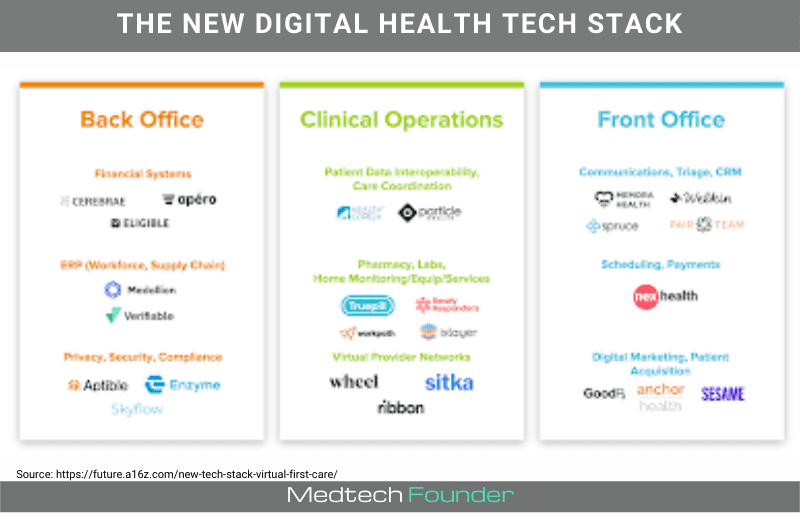
Digital Health Infrastructure Tools for 2023
There is an emerging ecosystem of healthtech companies that provide world-class tech-enabled services to the digital health market.
Today, each of these categories can be viewed as a micro-service where a digital health company might contract with multiple companies across these categories, or even create redundancy through multiple relationships within a category.
Many of these companies started within a very specific niche and have developed class-leading capabilities in a specific area. In the future, these companies will expand into adjacent areas, like Truepill for example.
Truepill started as virtual pharmacy API. They are now branching into telehealth and lab services.
The key to a successful digital health tech stack is interoperability.
Interoperability is the key to building a successful digital health application, as patients, physicians, clinicians, labs, and hospitals will need to interact seamlessly but still securely.
Interoperability should be the center of your digital health tech stack on a functional, structural, and semantic level.
Your client-side tech stack is what will be installed on a client’s machine of choice– such as their laptop, smartphone, etc. The client-side tech stack will make it possible for healthcare providers to run the environments and perform the tasks needed to run the app.
Server-side tech stacks are installed on a server. This tech stack will include all of the client-side technology in addition to database software and server software.
We mentioned the importance of implementing digital health infrastructure tools into your tech stack. However, nobody wants to have to build everything themselves.
Building your entire infrastructure and tech stack from the bottom-up is expensive, time-consuming, and usually not possible for many small digital health startups. And it’s a waste of resources in today’s market.
Do not build everything yourself. Spend the time upfront to identify a strategy where you leverage many of the great digital health infrastructure tools available today.
Let’s take a closer look at some of the key digital health infrastructure tools.
In the tech world, the cost of spinning up a startup plummeted like crazy thanks to Amazon’s Web Services (AWS). which lets startups rent out Amazon’s data storage and compute power.
This not only dropped the cost of starting a company from millions to hundreds of dollars but also allowed pay-as-use models that could scale with the companies as they grew.
Now, that same speed and cost reduction is coming to healthcare thanks to HIPAA-compliant cloud services. There are 119 different HIPAA-compliant AWS cloud services today vs 25 in 2017. Some of these are really cool healthcare-specific ones like AWS Comprehend Medical , which parses unstructured text data and maps it to different medical terms.
When it comes to the actual platforms your developers can use to build digital health and telehealth mobile and web apps, AWS Amplify is probably the most intuitive and simple platform to use. AWS Amplify is essentially a set of tools as well as services that can be used to help front-end developers build scalable, fully-fledged stack applications.
Amplify also supports pretty much every web framework under the sun, so it will integrate well with your framework of choice. Deployment with AWS Amplify is also quite simple.
If you’re considering working with connected medical devices. You’ll want to keep in mind device management services.
Phillips HealthSuite for example builds a layer on top of AWS to offer digital health-specific services for clinical and consumer applications and devices.
The Magic of Digital Health API’s
Api-as-a-service.
The proliferation of API-as-a-service has made it worth paying attention to in the digital health industry. One great API-first data solution to consider is Verifiable . This tool can be easily embedded into onboarding forms, thus making it possible for physician data to be pre-populated from a SSN. This significantly reduces friction throughout the provider onboarding process and removes many of the human error risks associated with data entry.
Eligible is a great product that could be used for back-office purposes for financial systems. This powerful API makes it easy to add insurance billing into your end product. In fact, this tool is trusted by developers from healthcare companies like Blue California and Omada. EHNAC accreditation, SOC II Compliance, and HiTrust certification are a few big perks to having this tool in your tech stack.
For patient data interoperability and care coordination, look at Particle . Particle makes it possible for startups to boost innovative solutions with data from hundreds of millions of patient records.
A rather simple API, Particle bridges the gap between digital health startups and the data being stored by thousands of hospitals and other networks. Particle’s API platform can unify this data into easy-to-work-with data records, secure access points, and so much more. If you have a limited development team, this intuitive tool could be very beneficial.
Ribbon Health is another great API-first company that provides healthcare enterprises with an API layer for accurate data on doctors, insurance plans, costs & quality of care. If you’re looking to build a provider network you’ll need the most accurate and up-to-date information (name, locations, hours, services offered, insurance accepted etc).
You’d be surprised how hard it is to keep directories up to date with this information. Ribbon’s API makes sure your directory is up to date always.
For EHR interoperability Redox is a leader in providing digital health companies API-based integration with many of the leading EHR systems like Epic and Cerner. They abstract away the complexity of this integration work and offer it a ready-made solution for a monthly fee. Many of the biggest medtech companies, like Stryker, Omron and Dexcom, work with Redox .
Suffice it to say that these are just a few of the API-as-a-service companies that support the digital health industry. The point here is that healthcare is complex and you need to test your value in the market as quickly as possible.
You’ll have a better shot at getting there if you’re not getting stuck trying to address outdated directories, EHR billing issues or provider credentialing challenges.
Use API-as-a-service infrastructure to build the foundation of your digital health startup.
Other useful tech stack tools
A few more digital health startup tech stack tools to consider include:
- ElasticSearch
- Anchor Health
- Amazon S3 and EC2
EMR and Existing Data registries
Verana Health and CorEvitas are taking this structured registry data and using it in new areas like life sciences. Registries are a viable approach to building a business, but the data is still coming from EMRs, so you’re not really replacing EMR so much as finding new use cases for the data.
Data registration is another big part of developing competitive and compliant digital health applications. Apache Spark is a unified analytics engine designed for the purpose of large-scale data processing. Apache Spark is popular because it can run workloads at lightning speeds, it’s very easy to use, it combines SQL with streaming with complex analytics, and it’s run virtually everywhere.
Many large organizations use Spark to process very large datasets, which is a vital ability to have if you’re dealing with massive amounts of patient and physician data. Plus, Spark is available as an open-source project– meaning you could potentially install and run it with absolutely no installation costs. Spark is also easy to program from most coding backgrounds, so your programming language of choice will implement well.
Bottom Line
One of the biggest benefits of this movement of digital health companies becoming buyers of healthtech is the raising of the quality bar for healthcare products—both in terms of the quality of the technology itself and that of the end-user experiences they enable.
To summarize:
- Look into what other successful digital startups have done and what they’re currently up to.
- Realize that there a ton of world-class companies building tools for digital health innovators
- Ensure that you invest your resources into proving your value in the market and not into rebuilding infrastructure that’s already out there.
- You do not have to build everything from the ground up by yourself. There are many excellent tools that you can implement.
How Medtech Founder Can Help
Medtech Founder was launched to help the medtech and digital health community launch their startups. Our goal is to boost the growth of successful digital health companies with more success than ever before. Specifically, we aim to guide and collaborate with startup founders to help them make the right choices when launching their company. From healthcare professionals to providers to entrepreneurs and tech developers, we’re helping pros in the digital health world by offering experience-based knowledge of the industry.
Get in touch with our team today to learn how we can help you get your digital health launch strategy right. Every entrepreneur deserves mentorship and assistance in the complex and intensive world of digital health. Medtech Founder is here to help!
How was our guide to building a digital health startup in 2023? We want to hear what your experience has been like in the comments below.
Join Me And The Community Of Innovators Shaping Digital Health Today
What’s trending.
- 10 Best Telemedicine Platforms for Healthcare Providers in 2024 January 7, 2024
- Telemedicine – How it works and how to increase your income in 2024 January 20, 2024
- 16 Best Digital Health Investors in 2024 January 4, 2024
Recent Posts
- 7 Best Digital Health Accelerators in 2024 February 2, 2024
- How to Build Amazing Digital Health Products That Patients Love January 20, 2024
- 10 Best APIs for Digital Health in 2024 January 16, 2024
- How to Get Started in Digital Health? A Comprehensive Guide January 15, 2024
- Digital Health How to Guide
- Digital Health Tools
- Remote Patient Monitoring
- Startup Funding
- Telemedicine
Recently Written

Author Christian
Join the discussion 7 comments.
- Pingback: 10 Best APIs for Digital Health in 2023 - Medtech Founder
- Pingback: 7 Best Digital Health Accelerators in 2023 - Medtech Founder
- Pingback: 15 Best Digital Health Investors in 2022 - Medtech Founder
- Pingback: 10 Best Telemedicine Platforms for Healthcare Providers in 2022
- Pingback: How to Build Amazing Digital Health Products That Patients Love - Medtech Founder
- Pingback: How to Get Started in Digital Health? A Comprehensive Guide
Leave a Reply Cancel Reply
Save my name, email, and website in this browser for the next time I comment.
Copyright © 2024 Medtech Founder All rights reserved.
- Make Money in Telemedicine
- Get Startup Funding
- Tools and Resources
- 7 Best Digital Health Accelerators in 2024
- How to Build Amazing Digital Health Products That Patients Love
- Telemedicine – How it works and how to increase your income in 2024
- 10 Best APIs for Digital Health in 2024
- How to Built a Digital Health Startup
- How to get Started in Digital Health
- How to Build Amazing Digital Health Products
- How to Maximize Your Telemedicine Revenue
- Best Telemedicine Platforms
- Best Remote Patient Monitoring Strategies
- Best Digital Health Investors
- Best Digital Health Accelerators
- How to Win SBIR Grants
- SBIR Proposal Templates
- Best APIs for Digital Health
- Digital Health Meetings
- Free NSF SBIR Template
- Free NIH SBIR Template
Join the Community
@medtechfounder
Healthcare App
Building a Successful Healthcare App: An In-Depth Guide
March 3, 2023
In today’s world, mobile applications have become an integral part of the healthcare industry. With the rise of telemedicine and the need for convenient healthcare services, the demand for healthcare apps has skyrocketed. However, building a healthcare app can be daunting, especially if you don’t have the right knowledge and resources. That’s why we’ve put together this in-depth guide to help you understand the crucial steps involved in developing a healthcare app that is both functional and successful.
Table of Contents
Healthcare Applications Overview
A healthcare application is a software for mobile devices that helps users manage their health and wellness in real-time. These apps can track a user’s vital signs, monitor their medication, schedule appointments with doctors, and provide access to medical records, among other features.
In the modern world, healthcare applications are increasingly relevant due to the widespread adoption of mobile devices and the growing demand for personalized healthcare solutions. These apps provide a convenient way for patients to manage their health, communicate with their doctors, and access medical information anytime, anywhere. Healthcare applications can potentially improve patient outcomes and increase efficiency in the healthcare industry. Here you can check all the required information about healthcare app development and customization .
What is the difference Between a Health App and a Medical App?
Health and medical apps may seem similar, but they have important differences. Here are some key distinctions:
Health apps:
– Designed for the general public
– Focus on providing health-related services and information
– Can be used without a claim on medical evidence
– Often cost less to develop
– Provide access to apps that track daily health data, such as fitness and wellness apps
Medical apps:
– Designed for medical professionals
– Focus on diagnosis and treatment based on analytical data
– Must comply with medical evidence and meet testing and adherence regulations
– The development process can be costly
– Provide access to electronic health records and patient information
3 Main Types of Healthcare Apps
Various types of healthcare apps are designed to meet the diverse needs of patients, medical professionals, and healthcare organizations. Here are three broad categories of healthcare apps:
1. Professional Healthcare Apps
These apps are designed for use by medical professionals, such as doctors, nurses, and medical students. They provide tools and resources to help medical professionals improve patient outcomes and increase efficiency in the healthcare industry. Examples of professional healthcare apps include Medical reference apps, Electronic health record (EHR) apps, and Medical calculator apps.
2. Healthcare Apps for Patients
These apps are designed to help patients manage their health and wellness. They provide a range of tools and resources to help patients track their symptoms, monitor their medication, and communicate with their doctors. Examples of healthcare apps for patients include Medication reminder apps, Fitness and wellness apps, and Telemedicine apps .
3. Health Apps for Medical Administration Staff
These apps are designed to help healthcare organizations manage their operations more efficiently. They provide tools and resources to help medical administrators manage staff, schedules, and patient data. Examples of health apps for medical administration staff include Medical billing and coding apps, Staff scheduling apps, and Patient management apps.
Benefits of Healthcare App for Doctors and Patients
—->benefits for doctors:.
– Faster decision making
– More accurate diagnosing
– Less stress and burnout
– Improved communication between professionals
– Better hospital and equipment management
– Reduced cost of healthcare provision
—-> Benefits for Patients:
– Higher quality care
– On-demand accessible care
– Better control over health data
– Secure payments
– Engagement
Use Cases for a Healthcare App
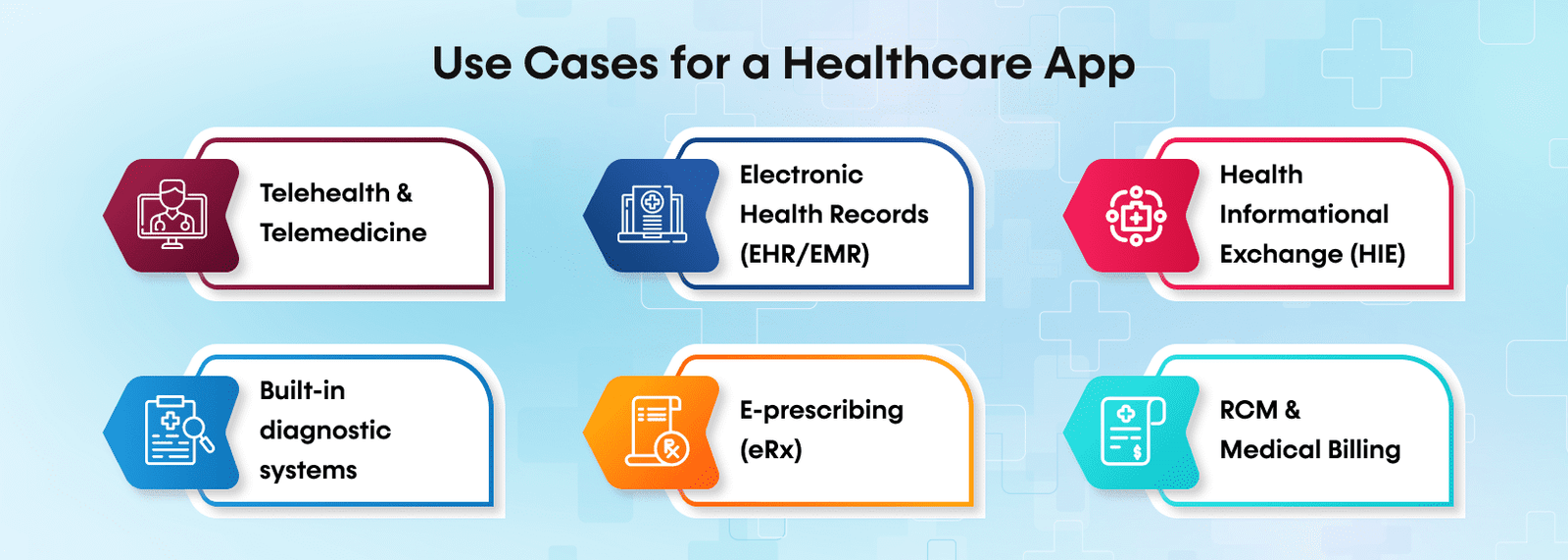
Healthcare apps have become essential for managing and improving medical care. Here are some of the most popular use cases for healthcare applications.
1. Telehealth & Telemedicine
Allows medical specialists to deliver remote medical services, communicate online and get efficient medical care faster.
2. Electronic Health Records (EHR/EMR)
EHR/EMR Software tracks, stores, updates, and collects all medical information about a patient on a single platform.
3. Health Informational Exchange (HIE)
Measures a patient’s vital parameters easily and quickly using only a smartphone’s authentication transfers data faster, and allows doctors to monitor and analyze the necessary information.
4. Built-in Diagnostic Systems
Collects and processes data from embedded and IoT devices integrated with EHR platforms, allowing doctors to visualize, analyze and diagnose remote patients.
5. E-prescribing (eRx)
Creates, stores, and sends out prescriptions using the medical information system in the electronic health ecosystem, minimizing errors during check-out and saving time.
6. RCM & Medical Billing
A medical billing system that covers EHR and Practices Management services, accessible on the go, saving users from investing in expensive hardware or worrying about IT, data encryption, and security compliance.
What is the Cost & Time Taken to Develop a Healthcare App?
The cost and time required to develop a healthcare app depend on the type of product, features, and team involved in healthcare app development services . It is crucial to clearly understand the requirements and target audience to build a successful app. By leveraging rapid prototyping and outsourcing to an agency in a cost-effective region, it is possible to develop a healthcare app without losing investors’ money.
It can take anywhere between 6-8 months for development. As for the cost, no definitive number can be stated as the software’s features depend on the customer, which can greatly vary the cost.
6 Main Steps to Build a Healthcare Mobile App
Here are the steps to follow while building a healthcare app:
Step 1 : Conduct a market analysis to study your niche, understand your competitors, and identify how you can stand out.
Step 2: Study your audience through user research, such as interviews, focus groups, or surveys, to find out the pain points of your target audience. Ensure to maintain an ethical balance while conducting user research.
Step 3: Choose the healthcare app type that aligns with your app’s database, functionality, and goal. Define key points with your team, such as the kind of app you need, how it will work, and what pains it will solve.
Step 4: Create a user-friendly and consistent design that leads the user to the endpoint smoothly, with fewer interaction points and reduced cognitive load.
Step 5: Ensure your app complies with HIPAA or GDPR to protect personal healthcare information. Follow a checklist that includes limiting access, ensuring data encryption, and using HIPAA-compliant services.
Step 6 : Build a Minimum Viable Product (MVP) to enter the market faster, prioritize vital features that solve the problem, and iterate constantly. The MVP will give you a competitive advantage and help you gather feedback from real users sooner.
Healthcare App MVP: Features Checklist
When building a healthcare app MVP, it’s important to prioritize the essential features that solve the problem you’re trying to address. Here’s a checklist for healthcare app MVP features.
—>For Doctor App:
– Doctor profiles
– One-on-one and group chats
– Calendar
– Notifications and alerts
– Patient health card
—> For Patient App:
– Patient profiles
– Chats
– Surveys
Must-Have Features in a Health Mobile Application
1. API & Integrations : APIs and integrations allow seamless communication and data exchange between healthcare systems and platforms.
2. Technology Stack for Healthcare Mobile App Development :
—> Backend Technologies: Common backend technologies for healthcare app development include Laravel, Node.js, and more
—> Frontend Technologies: React Native, Java, and Kotlin are popular choices for developing the front end of mobile healthcare apps.
3. Patient and Doctor Profiles :
Creating patient and doctor profiles help users easily access and manage their personal information and medical history.
4. Telemedicine Options:
Telemedicine features like one-on-one and group chats, video consultations, and appointment scheduling help patients and doctors communicate effectively and remotely.
5. Reminders and Notifications :
In-app reminders and notifications help patients manage their medication schedules and appointments, while doctors can receive real-time alerts for important updates and events.
6. Data Security Requirements :
Data security requirements in the USA, Canada, the UK, and the EU are stringent and require healthcare apps to comply with regulations such as HIPAA, PIPEDA, GDPR, and others.
What’s Next After You’ve Built a Healthcare App?
After building a healthcare app, it’s essential to continue improving it and gain user adoption. Here are some steps you can take:
– Sneak up on users and ask for feedback openly
– Watch for major OS updates and make sure your app remains compatible
– Spy on the competition and look for areas where you can improve your app
– Validate your idea with healthcare professionals and patients
– Leverage mobile app analytics to measure and improve the overall user experience
– Conduct A/B testing to identify and implement the best features
– Define how you will market and gain adoption of your app
– Use social media to promote your app
– Create an attractive landing page for your app
– Utilize traditional marketing methods to reach a wider audience.
Final Words
Choosing the right healthcare app development company is crucial for building a successful healthcare mobile app. EMed HealthTech is a leading healthcare app development company that can help you build an award-winning healthcare app.
With a team of experienced developers and a deep understanding of the healthcare industry, EMed HealthTech can create custom healthcare apps that meet your needs. From ideation and design to development and launch, EMed HealthTech can guide you through the entire process to ensure that your app succeeds.
Looking for reliable healthcare app development services? Our team will be happy to discuss your next healthcare app development project. Get in touch with us today!
Ami Kothari
Related posts

Healthcare App Development: Empowering Smart Solutions for Better Health
Smart Solutions for Health: The Power of Healthcare App Development

How to Choose the Right Development Company to Build a Healthcare App?
How to Choose the Right App Development Company to Build a Healthcare App

What Is the Cost of Developing a Mobile App for Healthcare?

Solving Healthcare Problems through Technology ™

- Testimonials
- Channel Partner Program
- Healthcare Regulatory Compliances
- ABDM Integration
- Terms & Conditions
- Privacy Policy
- Healthcare Digital Marketing
- Healthcare Data Analytics Services
- Custom Healthcare App Development
- Healthcare Software Development
- Healthcare Digital Transformation
- IOT Implementation in Healthcare
- Hospital Management System
- EHR/EMR Software
- Healthcare UI/UX Design Services
- Custom Remote Patient Monitoring Software
- Online Pharmacy
- Telemedicine
- Diagnostic Center
- Integrated Healthcare
- Medicine Delivery App
A-1201, SIDDHI VINAYAK TOWER, Makarba, Ahmedabad, Gujarat- 380051
2865 Lemieux Walk, London, Ontario N6L 0A9, Canada

Get an estimation
Just answer a few simple questions so we can personalize the right experience for you.
By filling in the form, you agree to our Privacy Policy including our cookie use.
Privacy Overview
WhatsApp us
Upmetrics AI Assistant: Simplifying Business Planning through AI-Powered Insights. Learn How
Entrepreneurs & Small Business
Accelerators & Incubators
Business Consultants & Advisors
Educators & Business Schools
Students & Scholars
AI Business Plan Generator
Financial Forecasting
AI Assistance
Ai Pitch Deck Generator
Strategic Planning
See How Upmetrics Works →
- Sample Plans
- WHY UPMETRICS?
Customer Success Stories
Business Plan Course
Small Business Tools
Strategic Planning Templates
E-books, Guides & More
- Sample Business Plans
- Medical & Health Care
Telemedicine Business Plan

Telehealthcare is a wide concept and is a hundred-billion-dollar industry in the USA itself. Leveraging this profitable market will indeed turn into a well-paying business opportunity for you.
It is a competitive market. To establish your telehealth business and ensure its growth and scalability, you need a comprehensive business plan that attracts desired investments.
Need help writing a business plan for your telemedicine business? You’re at the right place. Our telemedicine business plan template will help you get started.

Free Business Plan Template
Download our free business plan template now and pave the way to success. Let’s turn your vision into an actionable strategy!
- Fill in the blanks – Outline
- Financial Tables
How to Write A Telemedicine Business Plan?
Writing a telemedicine business plan is a crucial step toward the success of your business. Here are the key steps to consider when writing a business plan:
1. Executive Summary
An executive summary is the first section planned to offer an overview of the entire business plan. However, it is written after the entire business plan is ready and summarizes each section of your plan.
Here are a few key components to include in your executive summary:
Introduce your Business:
Start your executive summary by briefly introducing your business to your readers.
Market Opportunity:
Products and services:.
Highlight the telemedicine services you offer your clients. The USPs and differentiators you offer are always a plus.
Marketing & Sales Strategies:
Financial highlights:, call to action:.
Ensure your executive summary is clear, concise, easy to understand, and jargon-free.
Say goodbye to boring templates
Build your business plan faster and easier with AI
Plans starting from $7/month

2. Business Overview
The business overview section of your business plan offers detailed information about your company. The details you add will depend on how important they are to your business. Yet, business name, location, business history, and future goals are some of the foundational elements you must consider adding to this section:
Business Description:
Describe your business in this section by providing all the basic information:
Describe what kind of telemedicine company you run and the name of it. Briefly explain the type of telemedicine business you specialize in.
- Remote diagnosis
- Telehealth platform
- Virtual Consultation
- Teletherapy
- Specialty care
- Describe the legal structure of your telemedicine company, whether it is a sole proprietorship, LLC, partnership, or others.
- Explain where your business is located and why you selected the place.
Mission Statement:
Business history:.
If you’re an established telemedicine service provider, briefly describe your business history, like—when it was founded, how it evolved over time, etc.
Future Goals
This section should provide a thorough understanding of your business, its history, and its future plans. Keep this section engaging, precise, and to the point.
3. Market Analysis
The market analysis section of your business plan should offer a thorough understanding of the industry with the target market, competitors, and growth opportunities. You should include the following components in this section.
Target market:
Start this section by describing your target market. Define your ideal customer and explain what types of services they prefer. Creating a buyer persona will help you easily define your target market to your readers.
Market size and growth potential:
Competitive analysis:, market trends:.
Analyze emerging trends in the industry, such as technology disruptions, changes in customer behavior or preferences, etc. Explain how your business will cope with all the trends.
Regulatory Environment:
Here are a few tips for writing the market analysis section of your telehealth business plan:
- Conduct market research, industry reports, and surveys to gather data.
- Provide specific and detailed information whenever possible.
- Illustrate your points with charts and graphs.
- Write your business plan keeping your target audience in mind.
4. Products And Services
The product and services section should describe the specific services and products that will be offered to customers. To write this section should include the following:
Describe your services:
Mention the telemedicine services your business will offer. This list may include services like,
- Second opinion
- Prescription writing
- Follow-up care
Describe your service model
: Provide a detailed description of your service model briefly describing different ways of providing services.
- Video conferencing
- Telephonic calls
- Remote patient monitoring
Quality measures
: This section should explain how you maintain quality standards and consistently provide the highest quality service.
Additional Services
In short, this section of your telemedicine plan must be informative, precise, and client-focused. By providing a clear and compelling description of your offerings, you can help potential investors and readers understand the value of your business.
5. Sales And Marketing Strategies
Writing the sales and marketing strategies section means a list of strategies you will use to attract and retain your clients. Here are some key elements to include in your sales & marketing plan:
Unique Selling Proposition (USP):
Define your business’s USPs depending on the market you serve, the equipment you use, and the unique services you provide. Identifying USPs will help you plan your marketing strategies.
Pricing Strategy:
Describe your pricing strategy—how you plan to price your telehealth services and stay competitive in the local market.
Here are different pricing strategies for a telehealth company:
- Per encounter fee
- Service pricing
- Package pricing
- Subscription pricing
Marketing Strategies:
Sales strategies:, customer retention:.
Overall, this section of your telemedicine business plan should focus on customer acquisition and retention.
Have a specific, realistic, and data-driven approach while planning sales and marketing strategies for your telemedicine business, and be prepared to adapt or make strategic changes in your strategies based on feedback and results.
6. Operations Plan
The operations plan section of your business plan should outline the processes and procedures involved in your business operations, such as staffing requirements and operational processes. Here are a few components to add to your operations plan:
Staffing & Training:
Operational process:, equipment & machinery:.
Include the list of equipment and machinery required for telemedicine, such as computer systems, software, hardware, remote diagnostic tools, mobile applications, etc.
Adding these components to your operations plan will help you lay out your business operations, which will eventually help you manage your business effectively.
7. Management Team
The management team section provides an overview of your telemedicine business’s management team. This section should provide a detailed description of each manager’s experience and qualifications, as well as their responsibilities and roles.
Founders/CEO:
Key managers:.
Introduce your management and key members of your team, and explain their roles and responsibilities.
Organizational structure:
Compensation plan:, advisors/consultants:.
Mentioning advisors or consultants in your business plans adds credibility to your business idea.
This section should describe the key personnel for your telemedicine services, highlighting how you have the perfect team to succeed.
8. Financial Plan
Your financial plan section should provide a summary of your business’s financial projections for the first few years. Here are some key elements to include in your financial plan:
Profit & loss statement:
Cash flow statement:, balance sheet:, break-even point:.
Determine and mention your business’s break-even point—the point at which your business costs and revenue will be equal.
Financing Needs:
Be realistic with your financial projections, and make sure you offer relevant information and evidence to support your estimates.
9. Appendix
The appendix section of your plan should include any additional information supporting your business plan’s main content, such as market research, legal documentation, financial statements, and other relevant information.
- Add a table of contents for the appendix section to help readers easily find specific information or sections.
- In addition to your financial statements, provide additional financial documents like tax returns, a list of assets within the business, credit history, and more. These statements must be the latest and offer financial projections for at least the first three or five years of business operations.
- Provide data derived from market research, including stats about the telemedicine industry, user demographics, and industry trends.
- Include any legal documents such as permits, licenses, and contracts.
- Include any additional documentation related to your business plan, such as product brochures, marketing materials, operational procedures, etc.
Use clear headings and labels for each section of the appendix so that readers can easily find the necessary information.
Remember, the appendix section of your telemedicine business plan should only include relevant and important information supporting your plan’s main content.
The Quickest Way to turn a Business Idea into a Business Plan
Fill-in-the-blanks and automatic financials make it easy.
This sample telemedicine business plan will provide an idea for writing a successful telemedicine plan, including all the essential components of your business.
After this, if you still need clarification about writing an investment-ready business plan to impress your audience, download our telemedicine business plan pdf .
Related Posts
Medical Lab Business Plan
Medical Practice Business Plan
What are the Steps to Writing a Business Plan
Free Sample Business Plans Example
Hospital Business Plan
Medical Billing Business Plan
Frequently asked questions, how to get funding for your telemedicine business.
There are several ways to get funding for your telemedicine business, but self-funding is one of the most efficient and speedy funding options. Other options for funding are:
- Bank loan – You may apply for a loan in government or private banks.
- Small Business Administration (SBA) loan – SBA loans and schemes are available at affordable interest rates, so check the eligibility criteria before applying for it.
- Crowdfunding – The process of supporting a project or business by getting a lot of people to invest in your business, usually online.
- Angel investors – Getting funds from angel investors is one of the most sought startup options.
Apart from all these options, there are small business grants available, check for the same in your location and you can apply for it.
Where to find business plan writers for your telemedicine business?
There are many business plan writers available, but no one knows your business and ideas better than you, so we recommend you write your telemedicine business plan and outline your vision as you have in your mind.
What is the easiest way to write your telemedicine business plan?
A lot of research is necessary for writing a business plan, but you can write your plan most efficiently with the help of any telemedicine business plan example and edit it as per your need. You can also quickly finish your plan in just a few hours or less with the help of our business plan software .
How do I write a good market analysis in a telemedicine business plan?
Market analysis is one of the key components of your business plan that requires deep research and a thorough understanding of your industry. We can categorize the process of writing a good market analysis section into the following steps:
- Stating the objective of your market analysis—e.g., investor funding.
- Industry study—market size, growth potential, market trends, etc.
- Identifying target market—based on user behavior and demographics.
- Analyzing direct and indirect competitors.
- Calculating market share—understanding TAM, SAM, and SOM.
- Knowing regulations and restrictions
- Organizing data and writing the first draft.
Writing a marketing analysis section can be overwhelming, but using ChatGPT for market research can make things easier.
Can a good telemedicine business plan help me secure funding?
Indeed. A well-crafted telemedicine business plan will help your investors better understand your business domain, market trends, strategies, business financials, and growth potential—helping them make better financial decisions.
So, if you have a profitable and investable business, a comprehensive business plan can certainly help you secure your business funding.
What's the importance of a marketing strategy in a telemedicine business plan?
Marketing strategy is a key component of your telemedicine business plan. Whether it is about achieving certain business goals or helping your investors understand your plan to maximize their return on investment—an impactful marketing strategy is the way to do it!
Here are a few pointers to help you understand the importance of having an impactful marketing strategy:
- It provides your business an edge over your competitors.
- It helps investors better understand your business and growth potential.
- It helps you develop products with the best profit potential.
- It helps you set accurate pricing for your products or services.
About the Author
Upmetrics Team
Upmetrics is the #1 business planning software that helps entrepreneurs and business owners create investment-ready business plans using AI. We regularly share business planning insights on our blog. Check out the Upmetrics blog for such interesting reads. Read more
Plan your business in the shortest time possible
No Risk – Cancel at Any Time – 15 Day Money Back Guarantee
Popular Templates

Create a great Business Plan with great price.
- 400+ Business plan templates & examples
- AI Assistance & step by step guidance
- 4.8 Star rating on Trustpilot
Streamline your business planning process with Upmetrics .

Need a business plan? Call now:
Talk to our experts:
- Business Plan for Investors
- Bank/SBA Business Plan
- Operational/Strategic Planning
- L1 Visa Business Plan
- E1 Treaty Trader Visa Business Plan
- E2 Treaty Investor Visa Business Plan
- EB1 Business Plan
- EB2 Visa Business Plan
- EB5 Business Plan
- Innovator Founder Visa Business Plan
- UK Start-Up Visa Business Plan
- UK Expansion Worker Visa Business Plan
- Manitoba MPNP Visa Business Plan
- Start-Up Visa Business Plan
- Nova Scotia NSNP Visa Business Plan
- British Columbia BC PNP Visa Business Plan
- Self-Employed Visa Business Plan
- OINP Entrepreneur Stream Business Plan
- LMIA Owner Operator Business Plan
- ICT Work Permit Business Plan
- LMIA Mobility Program – C11 Entrepreneur Business Plan
- USMCA (ex-NAFTA) Business Plan
- Franchise Business Planning
- Landlord Business Plan
- Nonprofit Start-Up Business Plan
- USDA Business Plan
- Cannabis business plan
- eCommerce business plan
- Online Boutique Business Plan
- Mobile Application Business Plan
- Daycare business plan
- Restaurant business plan
- Food Delivery Business Plan
- Real Estate Business Plan
- Business Continuity Plan
- Buy Side Due Diligence Services
- ICO whitepaper
- ICO consulting services
- Confidential Information Memorandum
- Private Placement Memorandum
- Feasibility study
- Fractional CFO
- How it works
- Business Plan Examples
Medical Device Business Plan
Nov.06, 2023
Average rating 5 / 5. Vote count: 4
No votes so far! Be the first to rate this post.
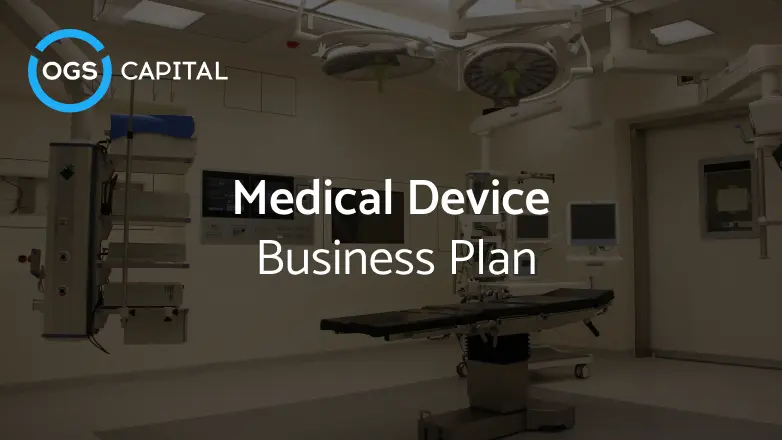
Table of Content
Medical Device Business Plan Sample
A medical device business plan is a document that outlines how to start and run a successful company that produces and sells products that diagnose, treat, or prevent diseases or injuries. Navigating the vast and expanding medical device sector presents thrilling opportunities alongside complex hurdles. A well-crafted business plan illuminates the route to success. Articulate your vision, milestones, tactics, and budgetary forecasts.
A business plan should also demonstrate how you will stand out from the crowd, satisfy users, adhere to regulations, and uphold ethical standards. A medical billing business plan is a specific type of medical device business plan that focuses on how to provide billing and coding services for healthcare providers.
In this article, we will provide you with a medical device business plan sample that you can use as a template or a reference for your business plan. We will cover the following sections:
- Executive Summary
- Company Overview
- Industry Analysis
- Customer Analysis
- Competitive Analysis
- Marketing Plan
- Operations Plan
Management Team
- Financial Plan
Executive Summary Section of Our Medical Device Business Plan
Business overview.
Medix is a medical device company that develops and sells innovative and affordable devices for diabetes management. We aim to enhance the well-being and health results of those managing diabetes. We aim to offer user-friendly and dependable products that assist in tracking and regulating blood sugar levels.
Products and Services
Medix offers two main products:
- Medix Glucometer – A smart glucose meter that connects to a mobile app via Bluetooth and provides accurate and instant readings of blood glucose levels.
- Medix Patch – A wearable patch that continuously measures blood glucose levels through the skin without needing finger pricks or test strips.
Customer Focus
Medix focuses on serving people with diabetes, seeking convenient and affordable solutions to manage their condition. According to the IDF Diabetes Atlas 10th edition report , 537 million adults (20-79 years) live with diabetes – 1 in 10. Experts predict that this number will rise to 643 million by 2030 and 783 million by 2045. Therefore, there is a huge demand for effective and accessible diabetes care products.
Leo Clark and Aria Bennett, two experienced entrepreneurs with biomedical engineering and business administration backgrounds, founded Medix. Leo is the CEO and head of product development, while Aria is the COO and head of marketing and sales. A team of qualified engineers, designers, developers, marketers, salespeople, and advisors supports them.
Success Factors
Medix has several competitive advantages that will enable it to succeed in the medical device industry:
- Innovation with cutting-edge technology to create novel devices
- High standards of quality and safety in every aspect of devices
- Customer satisfaction by providing user-friendly devices
- Social impact by addressing a major health problem globally
Financial Highlights
Medix seeks $5 million in seed funding to launch its products and scale its operations. The company projects to generate $1.2 million in revenue in the first year, $3.6 million in the second year, and $10.8 million in the third year, with a gross margin of 60% and a net profit margin of 20%. The company expects to break even in the second year and reach a valuation of $50 million by the end of the third year.
Company Overview Section of Our Medical Device Sales Business Plan

Who is Medix Medical Supply?
Medix dedicates itself to developing and selling innovative, affordable, and reliable devices for diabetes management. Our products help people with diabetes to monitor and control their blood glucose levels with ease and effectiveness, leading to better health outcomes and an improved quality of life.
Medix Medical Supply History
Medix is a company that provides innovative solutions for diabetes care. It was founded by Leo Clark and Aria Bennett in 2023, who both personally experienced the challenges and frustrations of living with diabetes. These challenges included frequent finger pricks, expensive test strips, inaccurate readings, and complicated insulin injections.
They started Medix with their personal funds and an incubator grant to address these issues. Medix developed two products – the Medix Glucometer and the Medix Patch – to make diabetes monitoring and treatment easier, more accurate, and more affordable.
The Medix products have received regulatory approvals from the Food and Drug Administration (FDA) and the European Medicines Agency (EMA). They are now ready for launch in the US and European markets. For more information, please refer to our dentistry business plan .
Legal Structure
Medix, an LLC registered in Delaware, USA, has obtained ownership by Leo Clark (60%) and Aria Bennett (40%). Additionally, the company has applied for a patent for its products in the US Patent and Trademark Office (USPTO).
Industry Analysis Section of Our Medical Device Business Plan
The medical device industry is one of the world’s most innovative and dynamic sectors. Fortune Business Insights reported that the global medical device market was valued at $512.29 billion in 2022 and can grow from $536.12 billion in 2023 to $799.67 billion by 2030, at a CAGR of 5.9%.
The medical device industry is driven by several factors, such as:
- The increasing prevalence of diseases and the aging population
- The rising demand for minimally invasive and personalized treatments
- The advancement of technology and digitalization
- The emergence of new markets and segments
Customer Analysis Section of Our Medical Supply Business Plan
Demographic profile of target market.
Medix’s target market is the US market, which ranks third for the highest number of people with diabetes. We target diabetic people looking for convenient, affordable solutions to manage their condition.
According to the National Diabetes Statistics Report by CDC, here are some interesting stats about why the US market is best for Medix:
- 37.3 million people have diabetes (11.3% of the US population)
- 28.7 million people are diagnosed, including 28.5 million adults
- 8.5 million people are undiagnosed (23.0% of adults)
- 96 million people aged 18 years or older have prediabetes (38.0% of the adult US population)
- 26.4 million people aged 65 years or older (48.8%) have prediabetes
The demographic profile of our target market is as follows:
- Age – We target all ages, mainly the young and middle-aged, who are tech-savvy and have more money to spend. A CDC report says 34.1 million adults aged 18 years or older—or 13.0% of all US adults—have diabetes.
- Gender – We target both males and females, as diabetes does not discriminate by gender. A NIDDK (NIH) report says a higher percentage of men (41%) than women (32%) have prediabetes.
- Income – We target all income levels, mainly the low and middle-income who need better healthcare solutions. An NCBI (NIH) report says 80% of the adults worldwide with diabetes live in low- and middle-income countries (LMICs).
Customer Segmentation
Based on our market research and customer feedback, we have identified four main customer segments for our products:
- Segment A – Tech-savvy innovators who value quality, performance, and convenience. They share their views online.
- Segment B – Cost-conscious buyers who seek affordable and effective products. They trust their peers’ recommendations.
- Segment C – Health-conscious improvers who want products that motivate and support them. They join online health communities.
- Segment D – Compliance-driven users need products that ensure safety, security, and simplicity. They depend on their health providers and caregivers.
The table below summarizes our findings:
Based on the table, we have decided to target segments A and B as our primary segments, and segments C and D as our secondary segments.
Competitive Analysis Section of Our Medical Equipment Producer Business Plan
Direct and indirect competitors.
Our direct competitors are other medical device companies that offer similar or substitute surgical medical equipment for diabetes management. Some of the major players in this category are:
1. Abbott – A global healthcare company that offers a range of products for diabetes care with mobile apps for real-time data and insights.
- Strong brand recognition
- Global presence
- Innovation capabilities
- Customer loyalty
Weaknesses:
- Limited availability
- Technical issues
2. Dexcom – A medical device company specializing in CGMs for diabetes management. These devices use sensors to record and transmit data to a receiver or a smartphone.
- High accuracy
- Reliability
- Convenience
- Customer satisfaction
- Short sensor lifespan
- Skin irritation
3. Medtronic – A medical technology company that offers a range of durable medical equipment for diabetes care, such as insulin pumps, CGMs, and APSs. The system connects to a mobile app to monitor and control settings.
- Leadership position
- Advanced technology
- Clinical evidence
- Customer support
- Safety concerns
- Regulatory hurdles
- Competition
Our indirect competitors are other healthcare providers or solutions that offer alternative or complementary ways to manage diabetes, such as medications, diet plans, exercise programs, coaching services, etc. Refer to our hospital business plan to learn more.
Competitive Advantage
Medix’s unique value proposition and competitive advantage over its competitors are:
- Medix is more innovative
- Medix is more convenient
- Medix is more versatile
- Medix is more affordable
- Medix is more user-friendly
Marketing Plan Section of Our Medical Device Business Plan
Promotions strategy.
We will promote our products using online and offline channels to attract and retain customers. Our promotional mix consists of:
- Advertising – Online platforms (e.g., Google Ads, Facebook Ads) and offline media (e.g., newspapers, billboards) to deliver relevant and engaging messages.
- Public Relations – Press releases, media interviews, podcasts, webinars, etc., to generate positive publicity and exposure. Social media platforms (e.g., Facebook, Twitter) to interact and communicate with customers and stakeholders.
- Sales Promotion – Discounts, coupons, free samples, free trials, referrals, loyalty programs, etc., to stimulate sales and repeat purchases. Contests, sweepstakes, giveaways, etc., to create excitement and buzz.
- Personal Selling – Direct sales, telemarketing, email marketing, etc., to contact and persuade customers to buy our products. Online platforms (e.g., Amazon, eBay, Shopify) to sell our products directly.
We will use a value-based pricing strategy that reflects the value and benefits of our products and our competitive advantage. We will also offer competitive pricing that matches or undercuts our competitors’ prices.
We will charge $100 for each Medix Glucometer and $50 for each Medix Patch. We will also generate recurring revenue from the sales of test strips ($0.5 each) and insulin cartridges ($10 each). We estimate that each customer will use an average of 100 test strips and 12 insulin cartridges per year.
Operations Plan Section of Our Medical Device Business Plan
Operation functions.
We do these core activities to offer our products and services to our customers:
- Product Development – We research, design, test, and improve our products using agile methods, customer feedback, market trends, and tools like GitHub, Jira, Figma, etc.
- Manufacturing – We produce our products on a large scale and high quality by outsourcing to a reliable contract manufacturer.
- Distribution – We deliver our products to our customers quickly and cheaply using direct and indirect channels in different regions or countries.
- Customer Service – We support and assist our customers before, during, and after their purchase using various channels and methods.
Milestones and Timeline
We have these specific goals and objectives to track our progress and success in our operation functions:
- June 2024: Complete R&D, testing, prototyping of products
- September 2024: Obtain regulatory approvals and certifications
- December 2024: Launch marketing campaign and product launch in the US
- March 2025: Market research for Europe entry
- December 2025: Launch Europe marketing, market entry
- March 2026: Invest in production capacity
- June 2026: Expand manufacturing workforce
- December 2026: Evaluate production, increase to 100k units/month
Management Team Section of Our Medical Device Business Plan
Founders and co-founders.
Leo Clark, a biomedical engineer with type 1 diabetes, and Aria Bennett, the daughter of a type 2 diabetic and a business administrator, founded Medix. Leo is responsible for the product development function, while Aria leads the marketing and sales function. Both have several years of experience working in their respective fields and personal and professional experience with diabetes.
Other Key Team Members
- Alice Lee – Our chief engineer
- Bob Chen – Our chief developer
- Carol Wang – Our chief designer
- Dave Jones – Our chief marketer
- Emma Smith – Our chief salesperson
Financial Plan Section of Our Medical Device Business Plan
Key revenue and costs.
Medix’s main sources of revenue, along with pricing, are:
- Medix Glucometer – $100 for each Glucometer
- Medix Patch – $50 for each Patch
- Test Strips – $0.5 for each test strip
- Insulin Cartridge – $10 for each cartridge
We estimate that each customer will use an average of 100 test strips and 12 insulin cartridges per year.
Medix’s main categories of expenses are:
- Cost of Goods Sold (COGS) – Our main cost of goods sold is the cost of materials, components, parts, and additional supplies. We estimate that the COGS per unit is $40 for the Medix Glucometer, $20 for the Medix Patch, $0.1 for the test strip, and $2 for the insulin cartridge.
- Operating Expenses (OPEX) – Our main operating expenses are the costs we incur for running and operating our business, such as salaries, rent, utilities, marketing, advertising, R&D, etc. Our OPEX will be 40% of our revenue in the first year, 35% in the second year, and 30% in the third year.
Funding Requirements and Use of Funds
Funding Requirements – We seek $5 million in seed funding to launch our products and scale our operations. We have already raised $500,000 from our savings and a small grant from a local incubator. We need an additional $4.5 million to cover our expenses for the next 18 months until we reach the break-even point.
Use of Funds – We will use the funds for the following purposes as highlighted in the below chart:
Key Assumptions
- Market size for our products is 10% of the total number of people with diabetes in the US and Europe
- Market share is projected to grow from 107,000 customers in 2024 to 444,000 customers in 2026
- Sales volume is projected to grow from 321,000 units in 2024 to 1.33 million units in 2026
- Gross margin is projected to be 60% in all three years
- Net margin is projected to grow from 20% in 2024 to 30% in 2026
Financial Projections
Based on the above assumptions, we have prepared the following financial projections for the next three years:
Income Statement
Ogscapital – your partner for medical device startup success.
With over a decade of experience, at OGSCapital, we have helped various entrepreneurs craft winning business plans. Our consultants provide end-to-end support – from market research and competitor analysis to realistic profitability forecasts. We understand the medical device industry inside-out, including regulations, manufacturing, and distribution.
Whether you need help with your hospital feasibility study , medical equipment manufacturing business plan, or medical supply store business plan, we tailor our approach to your specific product and goals. Partner with us to launch your startup on the path to profitability and rapid growth.
Frequently Asked Questions
How to start a medical device business.
A strategic business plan is a key ingredient in a startup medical device company. But that alone won’t cut it – the company also requires a talented group of professionals, structured product development procedures, a plan for meeting regulatory guidelines, and effective marketing tactics. A distributor or a medical equipment supplier can help distribute the devices.
How profitable are medical devices?
The medical equipment industry is booming with high growth potential. The average operating margin for medical equipment and supplies companies averages 2.87%. The medical device market will grow at a CAGR of 5.5% to 5.9% from 2022 to 2030.
How do I market my medical device?
As highlighted in our Medical Clinic Business Plan , some popular marketing channels to market a medical device include online platforms, social media, trade shows, conferences, webinars, publications, referrals, and testimonials. A medical equipment rental company can also help market the device.
OGSCapital’s team has assisted thousands of entrepreneurs with top-rate business plan development, consultancy and analysis. They’ve helped thousands of SME owners secure more than $1.5 billion in funding, and they can do the same for you.

Vegetable Farming Business Plan

Trading Business Plan

How To Write A Textile Manufacturing Business Plan

Start a Vending Machine Business in 2024: A Detailed Guide

Oil and Gas Business Plan

What Is Strategic Planning: Definition and Process

Any questions? Get in Touch!
We have been mentioned in the press:
Leave a Reply Cancel reply
Your email address will not be published. Required fields are marked *
Save my name, email, and website in this browser for the next time I comment.

Search the site:

Mobile Health Clinic Business Plan Template
Written by Dave Lavinsky

Mobile Health Clinic Business Plan
Over the past 20+ years, we have helped over 1,000 entrepreneurs and business owners create business plans to start and grow their mobile health clinic companies. We have the experience, resources, and knowledge to help you create a great business plan.
In this article, you will learn some background information on why business planning is important. Then, you will learn how to write a mobile health clinic business plan step-by-step so you can create your plan today.
Download our Ultimate Business Plan Template here >
What is a Mobile Health Clinic Business Plan?
A business plan provides a snapshot of your mobile health clinic business as it stands today, and lays out your growth plan for the next five years. It explains your business goals and your strategies for reaching them. It also includes market research to support your plans.
Why You Need a Business Plan for a Mobile Health Clinic
If you’re looking to start a mobile health clinic business or grow your existing mobile health clinic company, you need a business plan. A business plan will help you raise funding, if needed, and plan out the growth of your mobile health clinic business to improve your chances of success. Your mobile health clinic business plan is a living document that should be updated annually as your company grows and changes.
Sources of Funding for Mobile Health Clinic Businesses
With regards to funding, the main sources of funding for a mobile health clinic business are personal savings, credit cards, bank loans, and angel investors. When it comes to bank loans, banks will want to review your business plan (hand it to them in person or email to them as a PDF file) and gain confidence that you will be able to repay your loan and interest. To acquire this confidence, the loan officer will not only want to ensure that your financials are reasonable, but they will also want to see a professional plan. Such a plan will give them the confidence that you can successfully and professionally operate a business. Personal savings and bank loans are the most common funding paths for mobile health clinic companies.
Finish Your Business Plan Today!
How to write a business plan for a mobile health clinic business.
If you want to start a mobile health clinic business or expand your current one, you need a business plan. The guide and sample below details the necessary information for how to write each essential component of your mobile health clinic business plan.
Executive Summary
Your executive summary provides an introduction to your business plan, but it is normally the last section you write because it provides a summary of each key section of your plan.
The goal of your executive summary is to quickly engage the reader. Explain to them the kind of mobile health clinic business you are running and the status. For example, are you a startup, do you have a mobile health clinic business that you would like to grow, or are you operating a chain of mobile health clinic businesses?
Next, provide an overview of each of the subsequent sections of your plan.
- Give a brief overv iew of the mobile health clinic industry.
- Discuss the type of mobile health clinic business you are operating.
- Detail your direct competitors. Give an overview of your target customers.
- Provide a snapshot of your marketing strategy. Identify the key members of your team.
- Offer an overview of your financial plan.
Company Overview
In your company overview, you will detail the type of mobile health clinic business you are operating.
For example, you m ight specialize in one of the following types of mobile health clinic businesses:
- Neighborhood mobile health clinic : Often contracting with the city or county, mobile health clinics stop in certain neighborhoods at appointed times to offer general services to family members.
- Pregnancy and Motherhood Health Clinic: Typically provided by nonprofit corporations, these clinics assist with pregnancy testing, women’s health and early childhood care.
- Corporate Mobile Health Clinic: This service is offered to employees to provide standard tests, offer immunizations, and treat any construction on-site minor injuries.
- Blood Donation & Lab Tests Mobile Health Clinic: Provided by major donors and hospitals, mobile health clinics that solicit blood donations and provide lab tests are service-oriented and often free to the general public.
In addition to explaining the type of mobile health clinic business you will operate, the company overview needs to provide background on the business.
Include answers to questions such as:
- When and why did you start the business?
- What milestones have you achieved to date? Milestones could include the number of patients served, the number of cases with positive outcomes, reaching X number of clients served, etc.
- Your legal business structure. Are you incorporated as an S-Corp? An LLC? A sole proprietorship? Explain your legal structure here.
Industry Analysis
In your industry or market analysis, you need to provide an overview of the mobile health clinic industry.
While this may seem unnecessary, it serves multiple purposes.
First, researching the mobile health clinic industry educates you. It helps you understand the market in which you are operating.
Secondly, market research can improve your marketing strategy, particularly if your analysis identifies market trends.
The third reason is to prove to readers that you are an expert in your industry. By conducting the research and presenting it in your plan, you achieve just that.
The following questions should be answered in the industry analysis section of your mobile health clinic business plan:
- How big is the mobile health clinic industry (in dollars)?
- Is the market declining or increasing?
- Who are the key competitors in the market?
- Who are the key suppliers in the market?
- What trends are affecting the industry?
- What is the industry’s growth forecast over the next 5 – 10 years?
- What is the relevant market size? That is, how big is the potential target market for your mobile health clinic business? You can extrapolate such a figure by assessing the size of the market in the entire country and then applying that figure to your local population.
Customer Analysis
The customer analysis section of your mobile health clinic business plan must detail the customers you serve and/or expect to serve.
The following are examples of customer segments: individuals, schools, families, and corporations.
As you can imagine, the customer segment(s) you choose will have a great impact on the type of mobile health clinic business you operate. Clearly, individuals would respond to different marketing promotions than corporations, for example.
Try to break out your target customers in terms of their demographic and psychographic profiles. With regards to demographics, including a discussion of the ages, genders, locations, and income levels of the potential customers you seek to serve.
Psychographic profiles explain the wants and needs of your target customers. The more you can recognize and define these needs, the better you will do in attracting and retaining your customers. Ideally you can speak with a sample of your target customers before writing your plan to better understand their needs.
Finish Your Mobile Health Clinic Business Plan in 1 Day!
Don’t you wish there was a faster, easier way to finish your business plan?
With Growthink’s Ultimate Business Plan Template you can finish your plan in just 8 hours or less!
Competitive Analysis
Your competitive analysis should identify the indirect and direct competitors your business faces and then focus on the latter.
Direct competitors are othe r mobile health clinic businesses.
Indirect competitors are other options that customers have to purchase from that aren’t directly competing with your product or service. This includes mental health professionals, private practice providers, or private laboratories. You need to mention direct competition, as well.
For each direct competitor, provide an overview of their business and document their strengths and weaknesses. Unless you once worked at your competitors’ businesses, it will be impossible to know everything about them. But you should be able to find out key things about them such as
- What types of customers do they serve?
- What type of mobile health clinic business are they?
- What is their pricing (premium, low, etc.)?
- What are they good at?
- What are their weaknesses?
With regards to the last two questions, think about your answers from the customers’ perspective. And don’t be afraid to ask your competitors’ customers what they like most and least about them.
The final part of your competitive analysis section is to document your areas of competitive advantage. For example:
- Will you provide options for the uninsured?
- Will you offer products or services that your competition doesn’t?
- Will you provide better customer service?
- Will you offer better pricing?
Think about ways you will outperform your competition and document them in this section of your plan.
Marketing Plan
Traditionally, a marketing plan includes the four P’s: Product, Price, Place, and Promotion. For a mobile health clinic business plan, your marketing strategy should include the following:
Product : In the product section, you should reiterate the type o f mobile health clinic company that you documented in your company overview. Then, detail the specific products or services you will be offering. For example, will you provide free ultrasounds, discounted medications, x-ray services, or family counseling?
Price : Document the prices you will offer and how they compare to your competitors. Essentially in the product and price sub-sections of yo ur plan, yo u are presenting the products and/or services you offer and their prices.
Place : Place refers to the sites where your mobile health clinic is contracted to visit. Document where your company is situated and mention how the site will impact your success. For example, is your mobile health clinic business located in busy retail districts, business districts, or company-owned construction sites? Discuss how your sites might be the ideal location for your customers.
Promotions : The final part of your mobile health clinic marketing plan is where you will document how you will drive potential customers to your location(s). The following are some promotional methods you might consider:
- Advertise in local papers, radio stations and/or magazines
- Reach out to websites
- Distribute flyers to neighborhoods
- Engage in email marketing
- Advertise on social media platforms
- Improve the SEO (search engine optimization) on your website for targeted keywords
Operations Plan
While the earlier sections of your business plan explained your goals, your operations plan describes how you will meet them. Your operations plan should have two distinct sections as follows.
Everyday short-term processes include all of the tasks involved in running your mobile health clinic business, including answering calls, planning and providing mobile clinic services, billing insurance and/or corporate clients, etc.
Long-term goals are the milestones you hope to achieve. These could include the dates when you expect to book your Xth corporate client, or when you hope to reach $X in revenue. It could also be when you expect to expand your mobile health clinic business to a new city.
Management Team
To demonstrate your mobile health clinic business’ potential to succeed, a strong management team is essential. Highlight your key players’ backgrounds, emphasizing those skills and experiences that prove their ability to grow a company.
Ideally, you and/or your team members have direct experience in managing mobile health clinic businesses. If so, highlight this experience and expertise. But also highlight any experience that you think will help your business succeed.
If your team is lacking, consider assembling an advisory board. An advisory board would include 2 to 8 individuals who would act as mentors to your business. They would help answer questions and provide strategic guidance. If needed, look for advisory board members with experience in managing a mobile health clinic business or successfully running a small medical practice.
Financial Plan
Your financial plan should include your 5-year financial statement broken out both monthly or quarterly for the first year and then annually. Your financial statements include your income statement, balance s heet, and cash flow statements.
Income Statement
An income statement is more commonly called a Profit and Loss statement or P&L. It shows your revenue and then subtracts your costs to show whether you turned a profit or not.
In developing your income statement, you need to devise assumptions. For example, will you see 25 patients per day, and/or visit 10 sites per day ? And will sales grow by 2% or 10% per year? As you can imagine, your choice of assumptions will greatly impact the financial forecasts for your business. As much as possible, conduct research to try to root your assumptions in reality.
Balance Sheets
Balance sheets show your assets and liabilities. While balance sheets can include much information, try to simplify them to the key items you need to know about. For instance, if you spend $50,000 on building out your mobile health clinic business, this will not give you immediate profits. Rather it is an asset that will hopefully help you generate profits for years to come. Likewise, if a lender writes you a check for $50,000, you don’t need to pay it back immediately. Rather, that is a liability you will pay back over time.
Cash Flow Statement
Your cash flow statement will help determine how much money you need to start or grow your business, and ensure you never run out of money. What most entrepreneurs and business owners don’t realize is that you can turn a profit but run out of money and go bankrupt.
When creating your Income Statement and Balance Sheets be sure to include several of the key costs needed in starting or growing a mobile health clinic business:
- Cost of vehicles, medical and lab equipment and office supplies
- Payroll or salaries paid to staff
- Business insurance
- Other start-up expenses (if you’re a new business) like legal expenses, permits, computer software, and equipment
Attach your full financial projections in the appendix of your plan along with any supporting documents that make your plan more compelling. For example, you might include your list of contracted corporations or a list of insurance plans you accept.
Writing a business plan for your mobile health clinic business is a worthwhile endeavor. If you follow the template above, by the time you are done, you will truly be an expert. You will understand the mobile health clinic industry, your competition, and your customers. You will develop a marketing strategy and will understand what it takes to launch and grow a successful mobile health clinic business.
Mobile Health Clinic Business Plan FAQs
What is the easiest way to complete my mobile health clinic business plan.
Growthink's Ultimate Business Plan Template allows you to quickly and easily write your mobile health clinic business plan.
How Do You Start a Mobile Health Clinic Business?
Starting a mobile health clinic business is easy with these 14 steps:
- Choose the Name for Your Mobile Health Clinic Business
- Create Your Mobile Health Clinic Business Plan
- Choose the Legal Structure for Your Mobile Health Clinic Business
- Secure Startup Funding for Your Mobile Health Clinic Business (If Needed)
- Secure a Location for Your Business
- Register Your Mobile Health Clinic Business with the IRS
- Open a Business Bank Account
- Get a Business Credit Card
- Get the Required Business Licenses and Permits
- Get Business Insurance for Your Mobile Health Clinic Business
- Buy or Lease the Right Mobile Health Clinic Business Equipment
- Develop Your Mobile Health Clinic Business Marketing Materials
- Purchase and Setup the Software Needed to Run Your Mobile Health Clinic Business
- Open for Business
Where Can I Download a Free Business Plan Template PDF?
Click here to download the pdf version of our basic business plan template.
Our free business plan template pdf allows you to see the key sections to complete in your plan and the key questions that each must answer. The business plan pdf will definitely get you started in the right direction.
We do offer a premium version of our business plan template. Click here to learn more about it. The premium version includes numerous features allowing you to quickly and easily create a professional business plan. Its most touted feature is its financial projections template which allows you to simply enter your estimated sales and growth rates, and it automatically calculates your complete five-year financial projections including income statements, balance sheets, and cash flow statements. Here’s the link to our Ultimate Business Plan Template.
Don’t you wish there was a faster, easier way to finish your Mobile Health Clinic business plan?
OR, Let Us Develop Your Plan For You
Since 1999, Growthink has developed business plans for thousands of companies who have gone on to achieve tremendous success.
Click here to hire someone to write a business plan for you from Growthink’s team.
Other Helpful Business Plan Articles & Templates

Medical Practice Business Plan Template
Written by Dave Lavinsky
Medical Practice Business Plan
You’ve come to the right place to create your Medical Practice business plan.
We have helped over 10,000 entrepreneurs and business owners create business plans and many have used them to start or grow their Medical Practices.
Medical Practice Business Plan Example
Below is a template to help you create each section of your Medical Practice business plan.
Executive Summary
Business overview.
Fresno Medical is a new medical practice located in Fresno, California. Our goal is to provide affordable healthcare to individuals and families living in the area and surrounding communities. We offer general and preventative healthcare for all ages, including checkups, screening tests, and immunizations.
Our medical practitioners and supporting staff are well-trained and have a passion for improving the health and well-being of our clients. We serve our patients not just with our knowledge and skills but also with our hearts. We aim to help our patients experience the best healthcare possible while maintaining relationships that last a lifetime.
Service Offering
Fresno Medical practice will focus on providing primary care services to every family member, from infants to adults. Some of the general and primary care services we provide include:
- Immunizations: flu shots, COVID boosters, measles, mumps, polio, etc.
- Annual checkups
- Pediatrics: checkups, developmental screening, immunizations, etc.
- Health screenings: blood pressure, cholesterol, depression, diabetes, etc.
- General health counseling
Fresno Medical will work with local and national insurance companies to ensure that every patient can afford our services. If the patient’s insurance does not cover all of their medical costs, Fresno Medical will provide payment plan options so that they are not overwhelmed by their medical bills.
Customer Focus
Fresno Medical will primarily serve the community of Fresno, California. The community consists primarily of middle to lower income residents who need access to affordable medical care. Many of these residents are hesitant to go to hospitals or other medical facilities due to their costs. We will offer lower prices, flexible payment plans, and flexibility when working with insurance companies to accommodate this demographic.
Management Team
Fresno Medical is owned and operated by Jessica Wells, who has been working as a doctor at local hospitals for 15 years. Throughout her career, she has worked for hundreds of patients and families with all their general and preventative care needs. Though she has never run a medical practice herself, she has worked in the industry long enough to gain an in-depth knowledge of the business, including the operations side (e.g., running day-to-day operations) and the business management side (e.g., staffing, marketing, etc.).
Fresno Medical will also employ nurses, expert medical staff, and administrative assistants that are passionate about helping the local community.
Success Factors
Fresno Medical will be able to achieve success by offering the following competitive advantages:
- Location: Fresno Medical’s location is in a high-traffic area that is easily accessible to thousands of residents. It’s visible from the street with many people walking and driving to and from work on a daily basis.
- Patient-oriented service: Fresno Medical will have a staff that prioritizes the needs of the patients and educates them on the proper way to take care of themselves.
- Management: Jessica Wells has a genuine passion to help the community. Because of her previous experience and reputation in the medical community, she is fully equipped to open this practice.
- Relationships: Jessica Wells has developed strong connections with her patients and fellow staff throughout her career. Many patients have expressed interest in following Jessica to her new practice, and some former colleagues have shown interest in working for the clinic. Jessica also has relationships with medical equipment suppliers and insurance companies.
Financial Highlights
Fresno Medical is currently seeking $400,000 to launch. The capital will be used for funding capital expenditures, staffing, marketing expenses, and working capital.
The breakdown of the funding may be seen below:
- Clinic design/build: $100,000
- Medical supplies and equipment: $130,000
- Three months of overhead expenses (payroll, rent, utilities): $100,000
- Marketing and advertising: $50,000
- Working capital: $20,000
The following graph below outlines the pro forma financial projections for Fresno Medical.
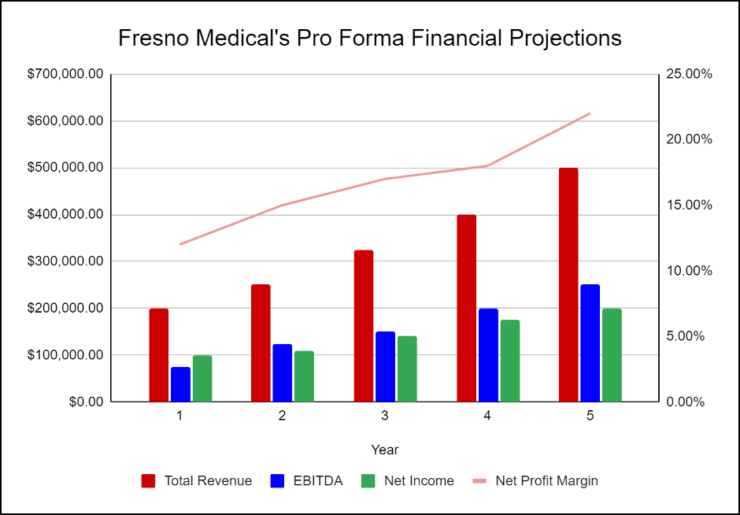
Company Overview
Who is fresno medical.
Fresno Medical is a medical practice located in Fresno, California. We offer general and preventative health care for all ages. We offer immunizations, pediatrics, health screenings, and more. Our medical practitioners and supporting staff are well-trained to improve the health and well-being of our patients.
Fresno Medical is run and owned by Jessica Wells, who has been a doctor in the local medical community for 15 years. She has helped hundreds of patients and families with their general healthcare needs throughout her career. She also has gained knowledge and experience in the operations and marketing aspects of the medical business, which will prove indispensable for this private practice.
Fresno Medical’s History
After years of working with patients in hospital settings, Jessica Wells decided to establish a private practice. She wanted to develop a closer relationship with her patients, which was difficult to achieve while working in a large hospital. With this goal in mind, Jessica incorporated Fresno Medical as an S-corporation on March 15th, 2023.
Since its incorporation, the medical practice has achieved the following milestones:
- Found a clinic space and signed a Letter of Intent to lease it
- Developed the company’s name, logo, and website
- Hired a contractor for the office build-out
- Determined equipment and fixture requirements
- Began recruiting key employees with previous healthcare experience
- Drafted marketing campaigns to promote the practice
Fresno Medical’s Services
Fresno Medical will focus on providing primary care services to every family member, from infants to adults. The costs will depend upon the materials used, the physician’s time, and the amount designated for each procedure. Some of the general and primary care services we provide include:
- Immunizations: flu shots, measles, mumps, polio, etc.
Fresno Medical will maintain privacy according to HIPAA regulations. All patients will be welcome, including those without insurance. However, we expect most patients to utilize their insurance plans to pay their costs. The medical practice will work with local and national insurance companies to ensure that every family can afford our services. After billing insurance, Fresno Medical will provide flexible payment plan options so that no patient is overwhelmed by their medical bills.
Industry Analysis
Healthcare is a human right that everyone deserves access to. The medical industry will always be a necessity as it is the industry keeping society alive and well. Therefore, the medical industry is expected to continue to grow as the population grows. This is especially true for private practices, as there is a rising demand for small, patient-focused clinics that provide top-tier medical services.
Furthermore, the demand for private physicians has been on the rise. Hospitals have been low on rooms and beds the past few years, and nurses and doctors have been overworked. This has led to an increased demand for more medical professionals and private practices that can help lessen the load of larger hospitals.
Moreover, the pandemic instilled the importance of quality healthcare and practices in the general population. We expect that people all around the world will now put in more effort towards taking care of their health and getting the care and screenings they need.
According to Facts & Factors, the global private medical market is expected to experience a compound annual growth rate (CAGR) of 12.5% over the next five years. This is enormous growth that is rarely seen in other industries. Furthermore, there is a growing demand for more primary care physicians as the general population aims to prevent developing chronic and preventable diseases. According to Grand View Research, the primary care market will experience a CAGR of 3.2% over the next 10 years, which is also moderate growth.
With such a demand for more medical practices and a greater emphasis on general health, we believe that Fresno Medical is starting at the right time and will see great success.
Customer Analysis
Demographic profile of target market.
Fresno Medical will serve the community residents of Fresno, California, and its surrounding areas. The community of Fresno, California has thousands of middle-class individuals and families seeking an affordable medical practice to take care of all their health concerns.
The demographics of Fresno, California are as follows:
Customer Segmentation
The company will primarily target the following customer segments:
- Middle-class individuals
- Hospital patients
Competitive Analysis
Direct and indirect competitors.
Fresno Medical will face competition from other companies with similar business profiles. A description of each competitor company is below.
City Metro Hospital
Founded in 1968, City Metro Hospital is one of the most popular hospitals in the area. Thousands of residents get all their primary care and emergency care needs taken care of with City Metro. It provides almost every service you can think of and enlists the help of thousands of doctors, nurses, and other expert medical professionals.
Though City Metro Hospital will continue to thrive, it does not foster an environment designed for long-lasting relationships. Since the pandemic, the hospital has been overwhelmed with patients and a staff shortage. This has led to doctors seeing thousands of patients and a tremendous increase in wait times. Fresno Medical will offer a more intimate setting where patients and doctors can create a long-lasting relationship that spans decades.
Quality Doctors
Quality Doctors is a private medical practice that provides highly personalized medical care. Quality Doctors includes a team of dedicated healthcare professionals with dual residency in emergency medicine and internal medicine. The practice offers same-day/next-day appointments, telemedicine, office visits, and home visits. Services offered by Quality Doctors include primary care, urgent care, and virtual visits.
Like City Metro Hospital, Quality Doctors is a large care system that cares for thousands of patients. This means that patients also do not get a close relationship with their doctor, which many crave. Furthermore, Quality Doctors has put much of its money and services toward emergency care in recent years and reduced its primary care services. Patients who want a lasting relationship with a primary care doctor will feel more welcome with Fresno Medical.
Johnson Community Care
Established in 1949, Johnson Community Care is a private medical practice with multiple locations. Patients all around the state can receive care at any location near them. Each site provides primary care services, emergency care, pharmacy services, and lab testing. Instead of heading to multiple locations to get all of these services, patients can get all their healthcare needs taken care of in one building.
Though Johnson is a highly successful medical practice, its major downfall is that it only provides services to those with its unique insurance plan. Therefore, anyone who has insurance through another company or plans provided by their employer cannot receive care at Johnson without paying out-of-network prices. Fresno Medical will partner with many insurance companies and provide flexible payment plans to help as many patients as possible.
Competitive Advantage
Fresno Medical enjoys several advantages over its competitors. These advantages include:
- Relationships: Jessica Wells has developed strong connections with her patients and fellow staff during her career. Many patients have expressed interest in following Jessica to her new practice, and some former colleagues have shown interest in working for the clinic. Jessica also has relationships with medical equipment suppliers and insurance companies.
Marketing Plan
Brand & value proposition.
The Fresno Medical brand will focus on the company’s unique value proposition:
- Client-focused healthcare services, where the company’s interests are aligned with the customer
- Service built on long-term relationships
- Big-hospital expertise in a small-clinic environment
- Moderate pricing for all preventative and general health services
Promotions Strategy
The promotions strategy for Fresno Medical is as follows:
Fresno Medical understands that the best promotion comes from satisfied patients. The clinic will encourage its patients to refer their friends and family by providing healthcare benefits for every new client produced. This strategy will increase in effectiveness after the business has already been established.
Social Media
We will maintain a social media presence to attract local clients looking for a new doctor or medical practice. We will post information about our team, services, and general health tips for better wellness. To create a genuine connection with our patients, we will also use social media to engage with them and answer any questions they may have about our practice.
Fresno Medical will have an informative and attractive website featuring all its services and referrals from other satisfied patients. The website will be highly informative and be designed in a way that is friendly and eye-catching.
Fresno Medical will invest in a high SEO presence so that the clinic is listed at the top of the Google or Bing search engine when a potential patient is researching private medical practices in Fresno, California.
Fresno Medical’s pricing will be significantly lower than big hospitals. We will partner with as many insurance companies as possible to ensure that our patients’ medical care is covered. For services not fully covered by insurance, we offer a flexible payment program so patients are not overwhelmed by their medical bills.
Operations Plan
The following will be the operations plan for Fresno Medical.
Operation Functions:
- Jessica Wells will operate as the CEO of Fresno Medical. She will run all the general operations and executive functions of the company. She will also provide basic medical care for patients until she can hire a full medical staff.
- Jessica is joined by Mindy Keller, who will serve as the Marketing Manager and run all of the marketing and advertising efforts.
- Jessica is also joined by Rhonda Smith, who will work as the Receptionist of the clinic and the Administrative Assistant for the company.
- Jessica is also joined by Cindy Nguyen who will be the company’s Head Nurse. She will manage and train incoming nurses and provide medical treatment to patients.
- Jessica will continue to hire a team of medical staff to treat the medical practice’s growing patient list. The team will consist of doctors, nurses, physicians, and other necessary medical staff.
Milestones:
Fresno Medical expects to achieve the following milestones in the following six months:
- 4/202X Finalize lease agreement
- 5/202X Design and build out Fresno Medical
- 6/202X Hire and train initial staff
- 7/202X Kickoff of promotional campaign
- 8/202X Launch Fresno Medical
- 9/202X Reach break-even
Fresno Medical is owned and operated by Jessica Wells, who has been working as a doctor at local hospitals for 15 years. Throughout her career, she has worked with hundreds of patients and families and taken care of all their general and preventative care needs. Though she has never run a private medical practice herself, she has worked in the industry long enough to gain an in-depth knowledge of the business, including the operations side (e.g., running day-to-day operations) and the business management side (e.g., staffing, marketing, etc.).
The medical practice will also employ nurses, expert medical staff, and administrative assistants that are passionate about helping the local community.
Financial Plan
Key revenue & costs.
The revenues for the medical practice will come from the fees it will charge the patients and their insurance for the health care services it provides.
The cost drivers for the company will include the payroll of the staff, lease on the office building, medical supplies and equipment, and marketing costs.
Funding Requirements and Use of Funds
Key assumptions.
The following outlines the key assumptions required in order to achieve the revenue and cost numbers in the financials and to pay off the startup business loan.
- Year 4: 100
- Year 5: 125
- Annual lease costs: $40,000
Financial Projections
Income statement, balance sheet, cash flow statement, medical practice business plan faqs, what is a medical practice business plan.
A medical practice business plan is a plan to start and/or grow your medical practice business. Among other things, it outlines your business concept, identifies your target customers, presents your marketing plan and details your financial projections.
You can easily complete your Medical Practice business plan using our Medical Practice Business Plan Template here .
What are the Main Types of Medical Practices?
There are a number of different kinds of medical practices , some examples include: Group medical practice, Private medical practice, and Hospital-based medical practice.
How Do You Get Funding for Your Medical Practice Business Plan?
Medical Practice businesses are often funded through small business loans. Personal savings, credit card financing and angel investors are also popular forms of funding.
A well-crafted medical practice business plan is key to securing any type of funding.
What are the Steps To Start a Medical Practice Business?
Starting a medical practice business can be an exciting endeavor. Having a clear roadmap of the steps to start a business will help you stay focused on your goals and get started faster.
1. Develop A Medical Practice Business Plan - The first step in starting a business is to create a detailed medical practice business plan that outlines all aspects of the venture. This should include market research on the medical industry and potential target market size, information the services or products you will offer, pricing strategies and a detailed financial forecast.
2. Choose Your Legal Structure - It's important to select an appropriate legal entity for your medical practice business. This could be a limited liability company (LLC), corporation, partnership, or sole proprietorship. Each type has its own benefits and drawbacks so it’s important to do research and choose wisely so that your medical practice business is in compliance with local laws.
3. Register Your Medical Practice Business - Once you have chosen a legal structure, the next step is to register your medical practice business with the government or state where you’re operating from. This includes obtaining licenses and permits as required by federal, state, and local laws.
4. Identify Financing Options - It’s likely that you’ll need some capital to start your medical practice business, so take some time to identify what financing options are available such as bank loans, investor funding, grants, or crowdfunding platforms.
5. Choose a Location - Whether you plan on operating out of a physical location or not, you should always have an idea of where you’ll be based should it become necessary in the future as well as what kind of space would be suitable for your operations.
6. Hire Employees - There are several ways to find qualified employees including job boards like LinkedIn or Indeed as well as hiring agencies if needed – depending on what type of employees you need it might also be more effective to reach out directly through networking events.
7. Acquire Necessary Medical Practice Equipment & Supplies - In order to start your medical practice business, you'll need to purchase all of the necessary equipment and supplies to run a successful operation.
8. Market & Promote Your Business - Once you have all the necessary pieces in place, it’s time to start promoting and marketing your medical practice business. This includes creating a website, utilizing social media platforms like Facebook or Twitter, and having an effective Search Engine Optimization (SEO) strategy. You should also consider traditional marketing techniques such as radio or print advertising.
Learn more about how to start a successful medical practice business:
- How to Open a Medical Practice
Medical & Healthcare Apps For Businesses In 2024
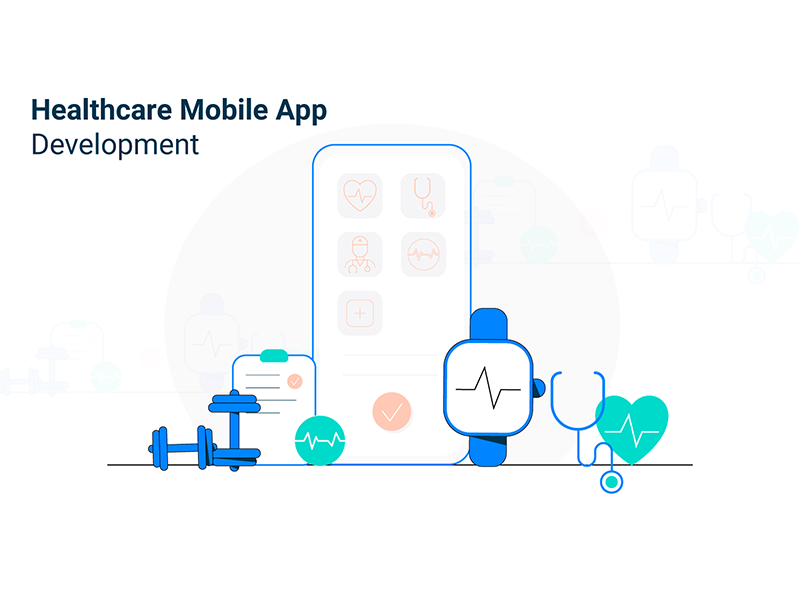
“Automation makes population health management feasible, scalable, and sustainable.” Institute of Health Technology Transformation
The current state of healthcare systems needs substantial improvement, especially in the recent outbreak of Covid-19. These days, Coronavirus has infected almost 215M people, with 4.47 M deaths worldwide. It has impacted the world and its economy drastically. New health app ideas are needed to confront the situation and come up with apps for medical services .
The sector has the potential for innovative trends, like IoT, Big Data, and AI. We will talk about the sectors of the best healthcare apps and come up with some popular applications in the market. The article may give you some good health app ideas that we can turn into a robust project.
How many health apps are there in 2023?
To understand the potential of the industry in terms of business perspectives and investment, consider statistics data. For 2021, the global mHealth market was valued at $38.2 billion . From 2021 to 2028, the market is predicted to grow at a CAGR of 34,8%, registering a value of $314.60 billion. The growing penetration of smartphones, 5G technology implementation and the users’ consciousness over health issues provide an unprecedented rise in mobile healthcare technologies.
The rise of mHealth demand increased mobile apps available in the App Store and Google Play market. Thus for Q1 2021, there were 53,979 iOS healthcare apps and 53,054 apps available at Google Play.
The Benefits of Integrating Mobile Apps in Healthcare and Patient Experience
The integration of healthcare services and innovative projects with the best healthcare apps is one of the ways to prevent epidemic situations and address other, no less important medical issues.
Healthcare automation and digitalisation across most of its sectors implies benefits , namely:
- Removal of bureaucracy
- Minimisation of human errors
- Improved medical treatments
Quicker diagnosis and pre-screening processes
- Remote patient monitoring
- Cutting the operational costs
- Improvement of global health
Speeding up the provision of healthcare service
- Access to the medical service in remote
- Unified and secure medical and patient databases.
How much does a medical app cost?
Mobile health application development is related to the most complicated development processes beyond simple programming. It requires regulations, security, and support. With a rough estimation, the average cost of a health mobile app is $425.000. It is the price of an app enhanced with the latest technologies. The price, though, does not include marketing and support services.
There is no universal pricing for app development. The price depends on many factors, and even the less significant element can change the price. The main cost drivers still remain the app complexity, the app’s features, and the dev team’s hourly rate.
There are more important elements to care about with mobile healthcare apps than, for example, interactive UI/UX. More than anything, healthcare apps should be secure, stable, and user-friendly. Here is a rough estimation of app development costs led by an average-rated dev team.
How to Create a Mobile App for Business?
App development needs to follow six-step business planning to make your idea compatible with business perspectives and market demands:
- Developing a business strategy
- Hiring development team
- Budgeting and planning
- Defining app features
- Marketing strategy
- Support and maintenance
WANT TO KNOW HOW MUCH DOES IT COST AN APP?
Find out cost drivers of app development in our blog.
Best Healthcare apps in Medical Services
Medical app development that utilizes the smartphone and functionality of other smart devices provides an advanced value. To develop the software operating on iPhone devices, applying specific tech stacks and following the platform guidelines is necessary. The same applies to the Android operating system.
To build an iOS or Android client app, it is necessary to use Swift and Kotlin programming languages. Applying technologies like Node.js, Python, Ruby, cloud-service platforms of AWS, EC2, S3, and PostgreSQL or MySQL databases is possible for the back-end developments and server setups.
Here are some of the apps popular in the market.
Doctor On Demand - Telehealth app
This app provides care on demand and by appointment. It is an iOS and Android app and is used in various physical and mental healthcare services.
Heal - Doctor house calls
HealpersonalisedWhen is an app to arrange a house call. It also applies to iOS and Android platforms.
Maven - Woman’s healthcare
Maven is designed for women and families. It is a kind of “digital clinic” where women and their families can turn for physical and mental health issues.
Fitbit - Activity tracker
This app allows us to monitor the state of health, including heartbeats, calories, fitness time, etc.
Healow - Health records management
Healow is the main communication tool between patients and their doctors. It records data and allows access to healthcare records.
MyChart - Patient portal
This app is also used for communication, allowing access to records, online scheduling, and paying the bills.
UpToDate - Educational portal
This app is designed for doctors and students—a powerful platform with vast medical information. Students and practitioners can have access to expert opinions.
Sonosupport - Ultrasound imaging support
This app is designed for ultrasound examinations. With the use of the app, it is possible to get clinical-grade ultrasound diagnostics at home.
Talkspace - Therapy
The online therapy platform gives access to psychiatrists and therapists for consulting and treatment via smartphone.
First Derm - Dermatology Services
The free app helps users connect to doctors, consult online, and get treatment and prescriptions for non-emergency skin issues.
Amwell - Insurance coverage
The application provides on-demand doctor visits and accepts health insurances, including United Healthcare, Aetna, Blue Cross Blue Shield, and more.
ZocDoc - Appointment scheduling
The application connects patients with different medical institutions to schedule appointments without calling or visiting to set an appointment.
GoodRx - Prescription discounts
It is a huge prescription database with over 75.000 medications where users can search for information and find the lowest medicine price in the area.
Medisafe - Medication reminder
With the app, the patients will never forget to take their prescriptions. Virtual pillbox sends reminders and notifications for taking medications.
Teladoc - On-demand Care
On-demand Telehealth service is an affordable way to connect to physicians and get virtual care for non-life-threatening cases.
WebMD - Medical resource
It is one of the largest medical resources and information databases that gives access to care directories, a database of medications, etc.
Generis - DNA & Nutrition
This innovative solution helps users understand their genes. The app provides DNA-based recommendations: food and nutrition, fitness advice, supplement recommendations, etc.
Better Help - Online consulting
It is a quick and cost-efficient way to access mental health professionals. The application is a convenient way to get online help from professional therapists and counselors.
MDacne - Acne treatment
The application is instant access to dermatologists and gets instant treatment based on the patient's answers, photos and videos. The app has a built-in chat to provide better communication between patients and doctors.
Leafly - One-stop-shop for cannabis information
The application’s main function is to connect doctors and patients, shed light on medical Marijuana properties, and educate users.
MySugr - Diabetes tracker
The lifesaver helps patients track blood sugar, carbs, estimated HbA1c and bolus within an app. With synchronized and updated data, it is easy to track changes and take actions if necessary.
EyeCare Live - Online consulting
The application is useful to get instant consulting on eye conditions through pictures and videos. Through visuals, the doctor can resolve the condition and advise treatment.
Heal - Physician house calls
The application is aimed at bringing back the traditional doctor’s visits. The holistic view will help doctors observe the lifestyle of a patient that may help in further treatment.
Factors to Consider When Building a Healthcare Mobile App
As one of the growing industries witnessing a boom of mobile integration, every new startup is entering a highly competitive market with global players that use the latest mobile and smart tech solutions. To be in line with global players, there are top factors to be considered when building an app.
- Integration of Medical Things
The IoT may be utilized in any health-related area by uniting medical hardware and software. The system uses different sensors and processors to collect data and share it across the network. The technology can connect not only with one device but also it is possible to create a complex ecosystem of interrelated tools and gadgets.
In the upcoming years, the implementation of IoT solutions is expected to grow, which is a subject of healthcare software development. Statista states that in 2020 almost 161 million IoT devices will be delivered and used.
When wearable devices, home medication dispensers, personalized trackers, digital cameras, and other medical equipment are interconnected, it will result in the next-level healthcare service, as stated by Forbes.
Vitals trackings, efficient operations in inventory management, treatments of chronic diseases, telehealth surgeries, built-in emergency response systems, and mood trackers are just a few directions where IoMT software can be implemented.
WANT TO KNOW HOW TO MAKE AN IOT APP?
Check out our blog.
It makes no doubt that the healthcare industry holds and processes huge masses of different information. Big Data allows for effective collecting and elaboration of internal medical documentation and patient data (EHR & EMR).
These operations surely remove bureaucracy among healthcare providers, improve patient diagnostics and care, and add value to medical research and the field of analytics.
Machine Learning and Artificial Intelligence
Advancements in language processing technology create and apply chatbots, voice recognition systems, voice assistants, etc. It is only the beginning of the story related to machine learning use cases. Automated healthcare operations with the help of ML and AI will bring user experience to the next level.
WANT TO KNOW HOW TO MAKE AN AI APP?
Blogs to get deeper knowledge about AI.
Blockchain technology is widely known due to the Bitcoin cryptocurrency. However, it is a great solution to provide top security and transparency levels within the healthcare industry. The technology removes paperwork and offers fast and secure information sharing.
HOW TO BUILD A BLOCKCHAIN APP?
Get insights into blockchain technology with our blog.
How can Addevice Help you Build a Healthcare Mobile App?
Still not sure about your health app ideas? The team of Addevice is an experienced offshore software provider that designs and develops top-notch healthcare applications based on IoT and AI. We create solutions for fitness and a healthy lifestyle, patient portals, and doctor-on-demand projects. Our team can also integrate and gain data from 100+ medical devices and 3rd party services to build a complex app functionality.
As an example, Addevice has projected and implemented Sentinel hypertension medical care application. The app aims to help patients with hypertension have safe life keeping health data under control. The application provides clinicians with real-time patient data, medication, and symptom management.
ARE YOU INTERESTED IN STARTING A BUSINESS?
Contact us for consulting.
Develop Your Mobile Health App
Transform healthcare experiences with your own mobile health app Our Expertise Covers: ✅ Telemedicine and virtual consultations ✅ Electronic health records integration ✅ Medication tracking and health monitoring features
Table of contents
Mobile health application development is related to the most complicated development processes beyond simple programming. It requires regulations, security, and support. With a rough estimation, the average cost of a health mobile app is $425.000. It is the price of an app enhanced with the latest technologies. The price, though, does not include marketing and support services.
The rise of mHealth demand increased mobile apps available in the App Store and Google Play market. Thus for Q1 2021, there were 53,979 iOS healthcare apps and 53,054 apps available at Google Play.
Rate this article
Give us your impressions about this article, relevant blogs.

Some are useful to improve and personalize your user experience with all the frills and the way our website works.
BUSINESS STRATEGIES
How to create a medical supply business plan
- Annabelle Amery
- Sep 5, 2023

When starting a business in the medical supply industry, creating a comprehensive and clear business plan is crucial to lay a strong foundation for success. This plan serves as a roadmap that guides the business owner through key aspects of the business's development and growth.
Crafting a well-structured medical supply business plan is not only essential for navigating the complexities of the medical industry, but also attracting potential investors, securing financing and establishing credibility.
Ultimately, a well-crafted medical supply business plan forms the bedrock of starting a successful medical supply venture, guiding the business toward achieving its goals in a dynamic and critical sector.
Looking to create a online business and get started with e-commerce ? Take Wix’s eCommerce website builder for a spin.
Benefits of starting a medical supply business plan
Writing a comprehensive business plan offers numerous advantages for any type of business . As it regards your medical supply business, a business plan is helpful for:
Attracting funding: A well-crafted business plan acts as a powerful tool to attract potential investors and raise money for starting a medical supply business. Investors want to see a clear understanding of the market potential, revenue projections and strategies for growth. A comprehensive plan demonstrates the business owner's commitment and professionalism, increasing the likelihood of obtaining financial support.
Resource planning: Starting a medical supply business involves a thorough understanding of the resources, supplies and staff needed to establish and operate the business smoothly. A detailed business plan forces you to research and outline the necessary equipment, regulatory compliance, logistics, staffing and partnerships. This clarity ensures that all aspects of your business are considered and addressed adequately.
Success planning: Creating a business plan enables business owners to develop a clear roadmap for success when starting a medical supply business. The plan outlines objectives, strategies and key performance indicators that guide your business's growth trajectory. It helps in setting measurable goals and tracking progress, allowing adjustments to be made to stay on course.
Identifying challenges and opportunities: A thorough market analysis within the business plan helps identify trends, challenges and opportunities in the medical supply industry. Understanding the competitive landscape, customer needs and industry shifts allows the business to tailor its offerings to meet market demands effectively.
Sustainability: Creating a financial plan within the business plan offers insights into revenue projections, expenses and profitability. It ensures that the medical supply business is financially viable and can sustain its operations in the long run. This plan also helps in managing cash flow and making informed decisions about budget allocation.
How to write a medical supply business plan in 6 steps
In the sections below, we’ll guide you through six essential steps to help you craft a comprehensive medical supply business plan that sets the stage for a thriving venture in the healthcare industry.
Executive summary
Business and domain names
Market analysis and research
Operations plan, marketing and advertising plan, financial plan, 01. executive summary.
The executive summary is a succinct overview of your medical supply business plan, providing a snapshot of the entire document. It encapsulates the essence of your business, its objectives, strategies and key points. This section is crucial as it often serves as the first impression for potential investors and stakeholders.
To craft a clear executive summary for your medical supply business, focus on introducing your medical supply business, its mission and its unique value proposition in the industry. Summarize the potential market demand for medical supplies. Then, highlight the types of medical supplies your business will offer, emphasizing any innovative or specialized items.
Describe what sets your medical supply business apart from competitors, such as quality, pricing, distribution network or customer service. You should also provide a glimpse into your revenue projections and growth potential, showcasing the financial attractiveness of your venture. Finally mention the initial funding required to launch your medical supply business and support its early operations.
Here’s an example of an executive summary for a medical supply venture: “MediAid Supplies is a pioneering medical supply business committed to providing healthcare professionals and facilities with the essential tools they need to deliver exceptional patient care. Our mission is to bridge the gap between quality medical supplies and their availability, ensuring that healthcare providers can focus on their vital roles without concerns about procurement challenges.
In an ever-evolving healthcare landscape, MediAid Supplies emerges as a reliable partner, offering a wide range of medical equipment, devices, and consumables. Our dedication to quality, affordability, and timely distribution positions us as a leader in the medical supply industry.
MediAid Supplies anticipates substantial revenue growth by addressing the escalating demand for reliable medical supplies and our commitment to unparalleled customer service. To achieve our vision, we are seeking strategic partnerships and investments that will support our expansion and outreach efforts.”
02. Business and domain names
Selecting a strong business name is crucial for a medical supply business to establish brand identity, build trust, and resonate with industry stakeholders. A well-chosen name should reflect professionalism, reliability and the scope of medical supplies offered. It's essential to ensure the chosen name is not already trademarked and is available for registration.
Using a business name generator can provide inspiration and generate creative ideas for your medical supply business name. Once the company name is finalized, securing a matching domain name for your business website is equally important in today's digital age.
Note: once you’ve settled on a business name and decided on the best structure for your business, you’ll want to register your business .
03. Market analysis and research
Incorporating a comprehensive market analysis and research section in your medical supply business plan is crucial. This section delves into understanding your target market, competitors and industry trends. It helps you craft effective marketing strategies and make informed business decisions.
04. Operations plan
The operations plan outlines practical aspects, such as the location of your medical supply business, premises design, equipment procurement, inventory management and staffing needs. It ensures you have a clear roadmap for effectively managing daily operations.
05. Marketing and advertising plan
The marketing and advertising plan lays out strategies and campaigns to effectively promote your medical supply business. It should highlight strategies such as digital marketing, trade shows, partnerships with healthcare facilities and campaigns that showcase the quality and reliability of your supplies.
Remember to keep your branding consistent no matter where you promote your business. Start by learning how to make a medical logo and then create your own with the use of a medical logo maker .
06. Financial plan
The financial plan is a critical component of a business plan for a medical supply business. It provides a comprehensive overview of the financial aspects of your business, including startup costs, funding sources, revenue projections, expenses and the time frame for reaching profitability. This section helps you demonstrate the financial viability of your business and assists potential investors and lenders in evaluating the potential return on their investment.
Startup costs and funding
Outline the initial investment required to launch your medical supply business. This includes expenses, such as:
Costs associated with procuring the initial inventory of medical supplies, equipment and devices.
Costs for leasing or purchasing a suitable location, interior design and furnishing.
Expenses for business registration, licenses, permits and compliance with industry regulations. For example, starting an LLC where costs vary between states.
Costs for creating a strong brand presence, including logo design, website development and marketing campaigns.
Estimate costs for utilities, insurance, salaries and any other recurring expenses for the initial period.
Funding sources
Identify the sources of funding you intend to utilize to cover your startup costs. These sources may include:
Personal savings: Investment from your personal savings or assets.
Bank loans: Securing loans from financial institutions.
Investors: Attracting equity investors who provide capital in exchange for ownership.
Partnerships: Partnering with other businesses or individuals to pool resources.
Revenue projections
Provide an estimate of your medical supply business's potential revenue over a specific period. Consider factors like the average transaction value, volume of sales and the pricing strategy for your products. Projections can be broken down by months or years to give a clear understanding of your growth trajectory.
Expenses and costs
Detail the anticipated expenses that your medical supply business will incur. Categorize them into fixed costs (rent, utilities, salaries) and variable costs (inventory, marketing, shipping). This breakdown helps you assess your business's cost structure and manage cash flow effectively.
Profit and loss projection
Present a profit and loss (P&L) projection that outlines your expected revenue and expenses over a specific period. The P&L statement calculates your net income or loss by subtracting total expenses from total revenue. This projection provides a clear picture of your business's financial health and potential profitability.
Break-even analysis
Perform a break-even analysis to determine the point at which your medical supply business's total revenue equals its total costs. This analysis helps you understand the minimum level of sales required to cover your expenses and begin generating profits.
Time frame for profitability
Indicate the expected time frame for your medical supply business to become profitable. This depends on various factors, including market demand, pricing strategy, marketing efforts and operational efficiency. Providing a realistic estimate helps stakeholders understand when they can expect a return on their investment.
Cash flow forecast
Prepare a cash flow forecast to track the inflows and outflows of cash in your medical supply business. This forecast helps you manage liquidity, plan for expenses and ensure you have adequate funds to cover operational needs.

Medical supply business plan example: MediCare Supplies
This draft business plan provides a really great starting point for creating your very own medical supply business plan. Remember to customize the content to your specific goals, target market, and location. Make sure to regularly review and update your business plan as your business grows to ensure its relevance and future success.
MediCare Supplies is a forward-thinking medical supply business aimed at providing high-quality medical equipment, devices, and consumables to healthcare facilities and professionals. Our mission is to enhance patient care by ensuring seamless access to reliable medical supplies. Leveraging our industry expertise and commitment to excellence, we aspire to become a trusted partner in the healthcare sector.
Company and domain names
Company name: MediCare Supplies
Domain name: www.medicaresupplies.com
Our chosen company name, "MediCare Supplies," signifies our dedication to supplying essential medical resources that contribute to the well-being of patients. The corresponding domain name, www.medicaresupplies.com, reinforces our commitment to providing a convenient online platform for healthcare professionals to access our products and services.
Our thorough market analysis indicates a growing demand for reliable medical supplies due to the expanding healthcare industry. Research reveals the need for a comprehensive supplier that offers a wide range of high-quality products. Our target audience includes hospitals, clinics, nursing homes and private practitioners seeking efficient procurement solutions.
Location: Strategically situated near medical facilities to facilitate timely deliveries and direct engagement.
Premises: A well-organized and efficient warehouse designed to accommodate our inventory and streamline operations.
Equipment: Cutting-edge inventory management systems and logistics software to optimize distribution and minimize errors.
Staffing: A team of experienced professionals in procurement, logistics and customer service to ensure seamless operations and client satisfaction.
Our marketing plan includes:
Digital presence: Making a website , optimizing it for search engines and maintaining active social media accounts to reach a wider audience.
Strategic partnerships: Collaborating with healthcare associations, medical facilities and industry influencers to increase brand visibility and credibility.
Educational content: Sharing informative blog posts, videos and webinars that provide insights into medical supply trends and best practices.
Email campaigns: Regular newsletters and updates to keep customers informed about new products, promotions and industry news.
Startup costs and funding:
Inventory procurement: $100,000
Warehouse setup: $30,000
Website development and branding: $20,000
Initial marketing: $15,000
Operational expenses (1st Quarter): $25,000
Total startup costs: $190,000
Funding sources:
Personal savings: $60,000
Bank loan: $100,000
Investment from partners: $30,000
Total funding: $190,000
Revenue projections:
Year 1: $500,000
Year 2: $800,000
Year 3: $1,200,000
Operating expenses:
Rent and utilities: $2,500 per month
Employee salaries: $100,000 per year
Marketing and advertising: $20,000 per year
Inventory restocking: $150,000 per year
Insurance and compliance: $5,000 per year
Profit and loss projection:
Year 1 net profit: Variable based on revenue and expenses
Break-even analysis:
Fixed costs (annual): total fixed costs (rent, salaries, etc.)
Average revenue per month: estimate average monthly revenue
Break-even point: fixed costs / average revenue per month
Time frame for profitability: MediCare Supplies anticipates achieving profitability within the first year of operation by executing effective marketing strategies and catering to the growing demand for reliable medical supplies.
Interested in other business ideas?
How to start an online business
How to start a consulting business
How to start a fitness business
How to start a fitness clothing line
How to start a makeup line
How to start a candle business
How to start a clothing business
How to start an online boutique
How to start a T-shirt business
How to start a jewelry business
How to start a subscription box business
How to start a beauty business
How to start a frozen food business
How to start a DJ business
How to start a flower business
How to start a plumbing business
How to start a baking business
How to start a babysitting business
How to start a virtual assistant business
How to start an eCommerce business
How to start a dropshipping business
How to start a farming business
How to start a food prep business
How to start a rental property business
Want to create another type of business plan?
How to create a real estate business plan
How to create a flower business plan
How to create a car wash business plan
How to create a contractor business plan
How to create a DJ business plan
How to create a dog walking business plan
How to create a clothing line business plan
How to create a construction business plan
How to create a painting business plan
How to create a plumbing business plan
How to create a rental property business plan
How to create a bar business plan
How to create a photographer business plan
How to create a cleaning business plan
How to create a restaurant business plan
How to create a coffee shop business plan
Related Posts
How to create a gym business plan
How to create flower business plan
Was this article helpful?

Medical Business Plan

You cannot start and run a successful medical business without writing and implementing a comprehensive business plan. A business plan gives you a complete framework for researching and analyzing the market, identifying possible opportunities, financing the project, and scaling it all together. Here are some of the best examples of medical business plans worth having a look.
Medical Practice Business Plan Template
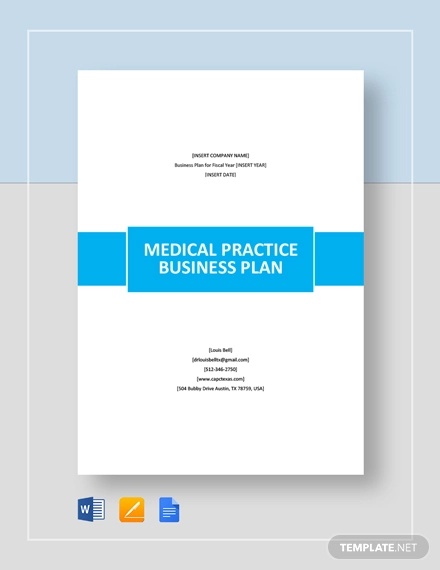
- Google Docs
Size: A4, US
Medical Laboratory Business Plan Template
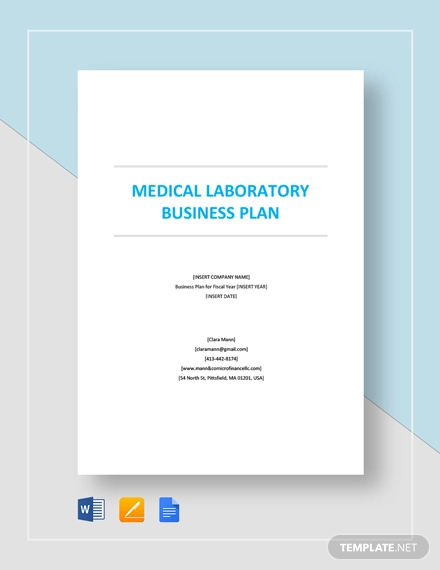
Dispensary Business Plan Template
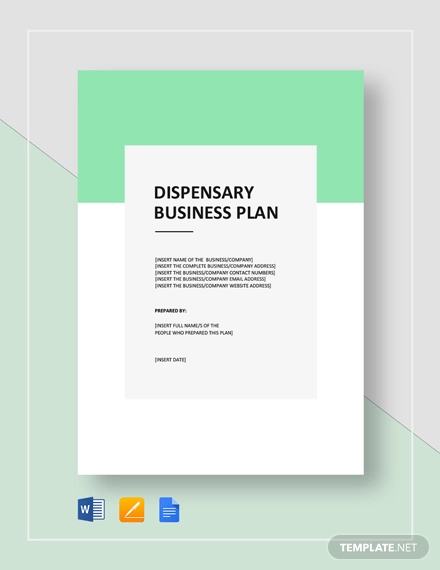
Fertility Clinic Business Plan Template
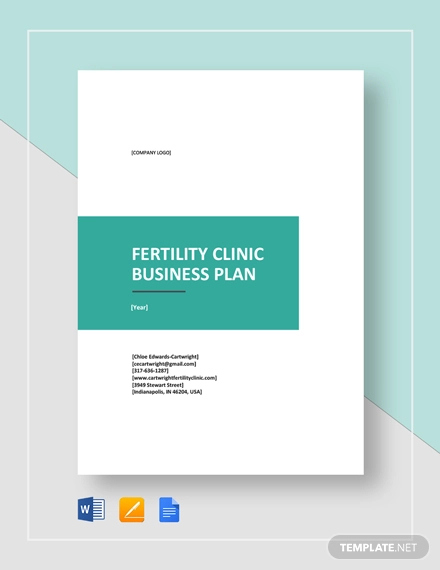
Fertility Clinic Marketing Plan Template
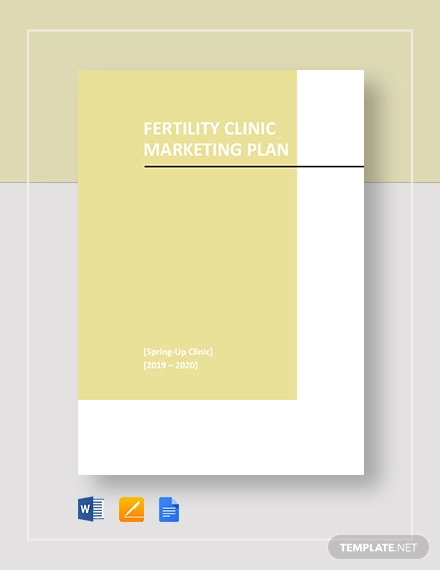
Pharma or Drug Sales Plan Template
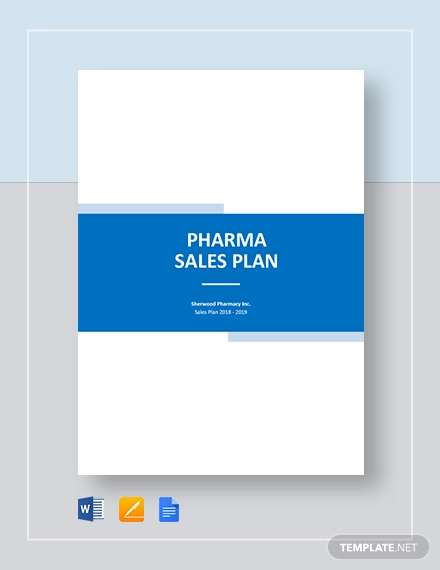
Medical Clinic Sales Plan Template
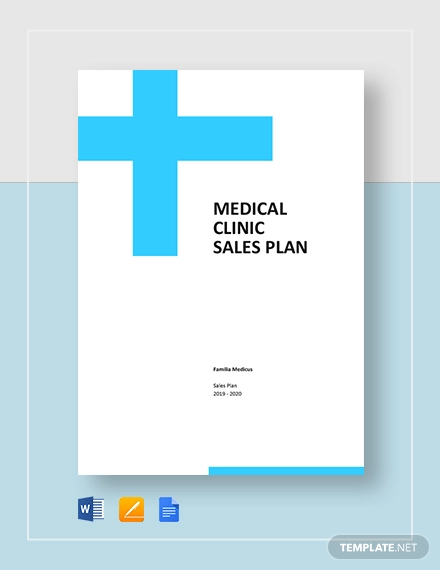
Medical Device Sales Plan Template
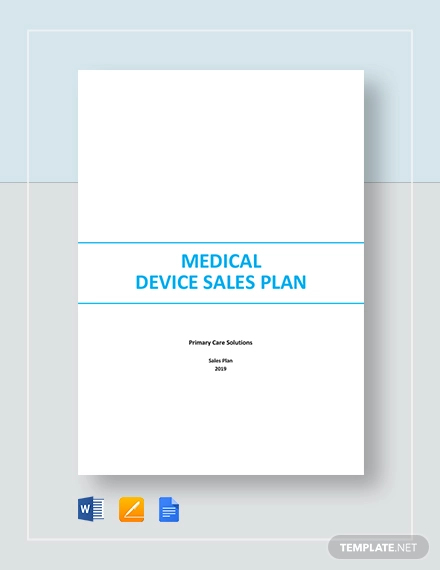
Executive Medical Reimbursement Plan Template

Best Medical Business Plan Examples & Templates
medical business plan example.

Size: 8.86 MB
If writing a medical business plan were easy, every business aspirant would do it with ease. To be clear, a comprehensive business plan for a new healthcare facility takes time to put together. But, what if you are green in this in the first place? The best thing to do is to look at a sample plan to get a clear picture of what a comprehensive strategy for a health facility looks like. This PDF file is a unique sample of a well-written business strategy for a healthcare facility. The plan covers everything you need to know about establishing a healthcare center, from business objectives and guiding principles to demographic analysis and their access to care.
Printable Medical Business Plan

Size: 780 KB
It doesn’t make sense to start a medical business without a strategy in place. You need to identify your audience, sturdy the market, conduct a SWOT analysis , and develop a marketing technique. This calls for a comprehensive business plan and here is an example that you can download and use as a guide to writing your own strategy. This sample will help you to understand a few things. First, you’ll learn how to write a clear summary of the proposed medical business. Second, you will see what a detailed business description looks like. Third, you will dive deep into learning and understanding the competition. Then, you will learn about financial strategy, which is important for starting and running a healthcare business at scale.
Free Medical Business Plan Example
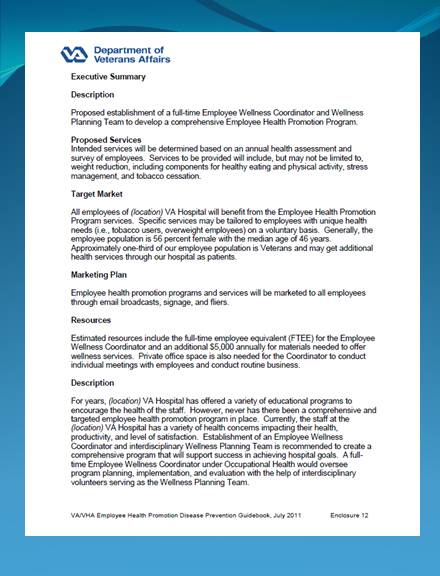
Size: 88 KB
It is important to understand that a business plan does not have to be complicated. It doesn’t have to be dozens or hundreds of pages either. In fact, you can set up and run a successful medical business with a very simple business plan . This PDF document is an example of a very simple business strategy, which a clear indication that even lean business plans can help you take a step in the right direction. This plan covers a number of sections, including an executive summary for the proposed business, proposed services, market evaluation, and marketing approach. Click the link above to download the PDF file.
Medical Practice Business Plan Example

Size: 237 KB
This PDF document is one of the most comprehensive medical business plans that you can read to understand what a professionally written business strategy looks likes. The 37-page file features a unique outline, which makes the entire document easy to scan. This file has a lot of information. From the executive summary and market sturdy to SWOT and market analysis , there is quite a lot to learn. The author uses a simple language throughout the document. So, whether you are green to writing a business proposal or you just need a simple example for reference, this is a good template to download.
Medical Startup Business Plan Example
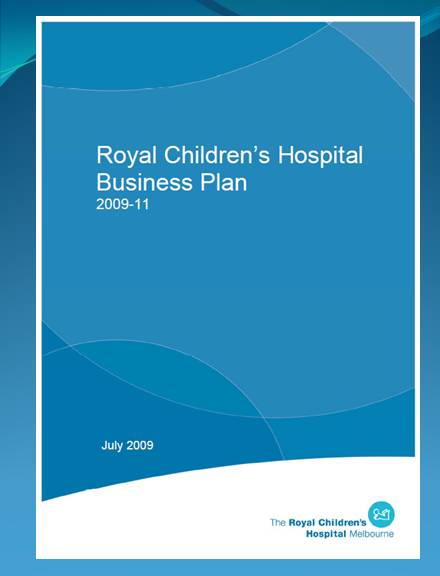
Size: 219 KB
You cannot start and run a successful business without a plan. In fact, many businesses that begin to operate without a strategy often close within the first six months. This happens across various industries, even in medical business. Now that you have made up your mind to start a medical business, you first need to write a business plan. If you have never written one before, don’t worry. You can just download this PDF file, read the entire strategy example, and then use the same knowledge that you pick from it to write a comprehensive business plan of your own. Click the link above to download this template.
Medical Business Plan Example for Clinic
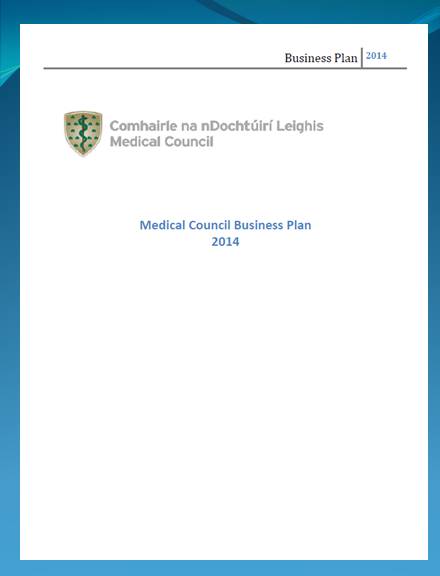
Size: 262 KB
Ask every serious entrepreneur what it takes to start and run a successful business and they’ll tell you that the first thing you need is a business plan. This tells you that a successful business depends on a comprehensive strategy . Now that you have made up your mind that it is time for you and your stakeholders to start a clinic in your locale, it’s important to write a business plan before investing money in the project. The plan will enable you to determine whether the business is feasible to pursue. By finding, connecting with, and studying the target market, it becomes easy to understand your business even before starting it. Download this medical plan for the clinic to learn more.
Private Hospital Business Plan Example
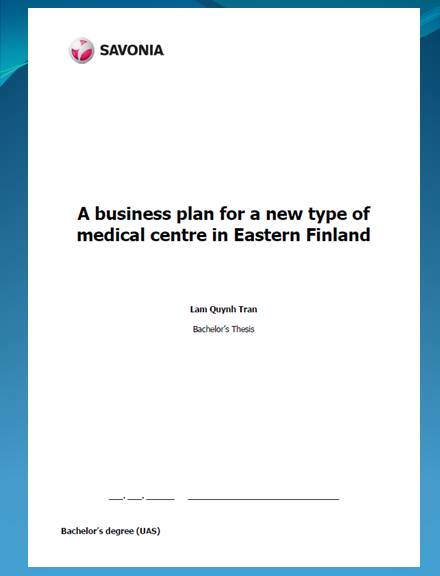
Size: 2.15 MB
Even if you have enough funding to start a private hospital, you’ll need to do in-depth research and then come up with a solid business plan that will help you set up the enterprise. At the end of the day, your goal is to run a successful business . This is something you can’t do if you start with a proper strategy. Remember, the success of your private medical startup will depend on the structure of the plan. The success of the upcoming business will depend on the structure of the plan. In other words, a business plan is a must-have.
Simple Medical Business Plan Example
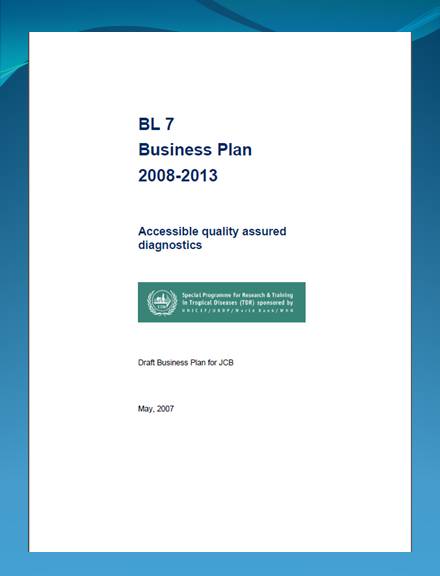
Size: 141 KB
You already know that it is difficult to run a successful business without a plan. So, if you want to set up a new medical facility in your area, first start by writing a business plan for the foreseen startup. The PDF file above is a unique example of a business plan that you can use for reference. This guide is important because it focuses on the most important elements that make up a comprehensive business plan.
Comprehensive Business Plan for Medical Facility
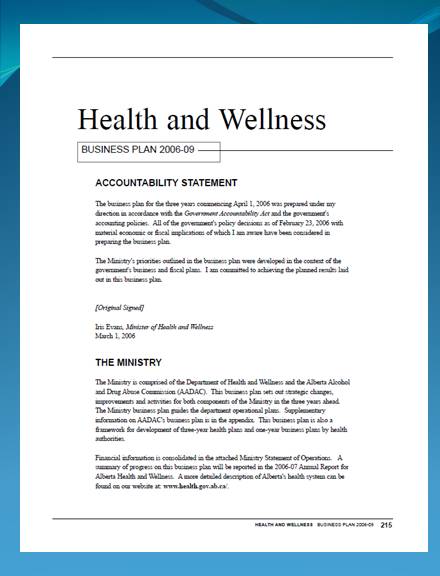
You can use this sample template to write a comprehensive business plan for a medical facility. Some of the highlights include identifying challenges and determining their respective opportunities. This gives you a clear understanding of the market that you would like to target so that you can align your medical services to their needs once you start operation.
Short Medical Business Plan Example

Size: 264 KB
If you are the kind of a medical business enthusiast who prefers to write a short business plan, this example is suitable for you. The content of the file includes an executive summary, market analysis, business growth, marketing strategy, and financial projection.
Text prompt
- Instructive
- Professional
Create a study plan for final exams in high school
Develop a project timeline for a middle school science fair.
Medical Supplies Business Plan Template & Guidebook
Starting a medical supplies business is an excellent way to serve a growing segment of the health industry and become your own boss in the process. With the #1 Medical Supplies Business Plan Template & Guidebook, you can create a step-by-step plan to help you launch and grow your business. From researching the market to setting goals and objectives and finding the right legal structure, this guidebook takes you through every step of the journey so that you can become a success in medical supplies.

Get worry-free services and support to launch your business starting at $0 plus state fees.
- How to Start a Profitable Medical Supplies Business [11 Steps]
- 10+ Best & Profitable Medical Supplies Business Ideas [2023]
How to Write a Medical Supplies Business Plan in 7 Steps:
1. describe the purpose of your medical supplies business..
The first step to writing your business plan is to describe the purpose of your medical supplies business. This includes describing why you are starting this type of business, and what problems it will solve for customers. This is a quick way to get your mind thinking about the customers’ problems. It also helps you identify what makes your business different from others in its industry.
It also helps to include a vision statement so that readers can understand what type of company you want to build.
Here is an example of a purpose mission statement for a medical supplies business:
Our mission is to provide effective, reliable, and affordable medical supplies and services to both individuals and organizations, empowering them to confidently manage their own health and wellness. By delivering high-quality products and services, we strive to improve the quality of life of our customers.

2. Products & Services Offered by Your Medical Supplies Business.
The next step is to outline your products and services for your medical supplies business.
When you think about the products and services that you offer, it's helpful to ask yourself the following questions:
- What is my business?
- What are the products and/or services that I offer?
- Why am I offering these particular products and/or services?
- How do I differentiate myself from competitors with similar offerings?
- How will I market my products and services?
You may want to do a comparison of your business plan against those of other competitors in the area, or even with online reviews. This way, you can find out what people like about them and what they don’t like, so that you can either improve upon their offerings or avoid doing so altogether.

3. Build a Creative Marketing Stratgey.
If you don't have a marketing plan for your medical supplies business, it's time to write one. Your marketing plan should be part of your business plan and be a roadmap to your goals.
A good marketing plan for your medical supplies business includes the following elements:
Target market
- Who is your target market?
- What do these customers have in common?
- How many of them are there?
- How can you best reach them with your message or product?
Customer base
- Who are your current customers?
- Where did they come from (i.e., referrals)?
- How can their experience with your medical supplies business help make them repeat customers, consumers, visitors, subscribers, or advocates for other people in their network or industry who might also benefit from using this service, product, or brand?
Product or service description
- How does it work, what features does it have, and what are its benefits?
- Can anyone use this product or service regardless of age or gender?
- Can anyone visually see themselves using this product or service?
- How will they feel when they do so? If so, how long will the feeling last after purchasing (or trying) the product/service for the first time?
Competitive analysis
- Which companies are competing with yours today (and why)?
- Which ones may enter into competition with yours tomorrow if they find out about it now through word-of-mouth advertising; social media networks; friends' recommendations; etc.)
- What specific advantages does each competitor offer over yours currently?
Marketing channels
- Which marketing channel do you intend to leverage to attract new customers?
- What is your estimated marketing budget needed?
- What is the projected cost to acquire a new customer?
- How many of your customers do you instead will return?
Form an LLC in your state!

4. Write Your Operational Plan.
Next, you'll need to build your operational plan. This section describes the type of business you'll be running, and includes the steps involved in your operations.
In it, you should list:
- The equipment and facilities needed
- Who will be involved in the business (employees, contractors)
- Financial requirements for each step
- Milestones & KPIs
- Location of your business
- Zoning & permits required for the business
What equipment, supplies, or permits are needed to run a medical supplies business?
- Business license
- Medical Supplies
- Computers and other office equipment
- Business insurance
- Employee payroll software
- Point-of-sale system for tracking orders and inventory levels
- Accounting software to manage accounts receivable, accounts payable and payroll
- Certifications or other credentials required to operate a medical supplies business
5. Management & Organization of Your Medical Supplies Business.
The second part of your medical supplies business plan is to develop a management and organization section.
This section will cover all of the following:
- How many employees you need in order to run your medical supplies business. This should include the roles they will play (for example, one person may be responsible for managing administrative duties while another might be in charge of customer service).
- The structure of your management team. The higher-ups like yourself should be able to delegate tasks through lower-level managers who are directly responsible for their given department (inventory and sales, etc.).
- How you’re going to make sure that everyone on board is doing their job well. You’ll want check-ins with employees regularly so they have time to ask questions or voice concerns if needed; this also gives you time to offer support where necessary while staying informed on how things are going within individual departments too!
6. Medical Supplies Business Startup Expenses & Captial Needed.
This section should be broken down by month and year. If you are still in the planning stage of your business, it may be helpful to estimate how much money will be needed each month until you reach profitability.
Typically, expenses for your business can be broken into a few basic categories:
Startup Costs
Startup costs are typically the first expenses you will incur when beginning an enterprise. These include legal fees, accounting expenses, and other costs associated with getting your business off the ground. The amount of money needed to start a medical supplies business varies based on many different variables, but below are a few different types of startup costs for a medical supplies business.
Running & Operating Costs
Running costs refer to ongoing expenses related directly with operating your business over time like electricity bills or salaries paid out each month. These types of expenses will vary greatly depending on multiple variables such as location, team size, utility costs, etc.
Marketing & Sales Expenses
You should include any costs associated with marketing and sales, such as advertising and promotions, website design or maintenance. Also, consider any additional expenses that may be incurred if you decide to launch a new product or service line. For example, if your medical supplies business has an existing website that needs an upgrade in order to sell more products or services, then this should be listed here.
7. Financial Plan & Projections
A financial plan is an important part of any business plan, as it outlines how the business will generate revenue and profit, and how it will use that profit to grow and sustain itself. To devise a financial plan for your medical supplies business, you will need to consider a number of factors, including your start-up costs, operating costs, projected revenue, and expenses.
Here are some steps you can follow to devise a financial plan for your medical supplies business plan:
- Determine your start-up costs: This will include the cost of purchasing or leasing the space where you will operate your business, as well as the cost of buying or leasing any equipment or supplies that you need to start the business.
- Estimate your operating costs: Operating costs will include utilities, such as electricity, gas, and water, as well as labor costs for employees, if any, and the cost of purchasing any materials or supplies that you will need to run your business.
- Project your revenue: To project your revenue, you will need to consider the number of customers you expect to have and the average amount they will spend on each visit. You can use this information to estimate how much money you will make from selling your products or services.
- Estimate your expenses: In addition to your operating costs, you will need to consider other expenses, such as insurance, marketing, and maintenance. You will also need to set aside money for taxes and other fees.
- Create a budget: Once you have estimated your start-up costs, operating costs, revenue, and expenses, you can use this information to create a budget for your business. This will help you to see how much money you will need to start the business, and how much profit you can expect to make.
- Develop a plan for using your profit: Finally, you will need to decide how you will use your profit to grow and sustain your business. This might include investing in new equipment, expanding the business, or saving for a rainy day.
Frequently Asked Questions About Medical Supplies Business Plans:
Why do you need a business plan for a medical supplies business.
A business plan for a medical supplies business is needed to help plan operational and financial strategies, set goals and objectives, gain investor backing or financing, and act as a roadmap for the future of the business. It outlines the vision and goals of the business, the market it operates in, a detailed SWOT analysis, an evaluation of potential competitors, strategies for marketing and sales, financial projections, how the company will be structured and managed, profit margins, staffing requirements and other critical elements to ensure successful operations.
Who should you ask for help with your medical supplies business plan?
The best person to ask for help with a medical supplies business plan is an experienced business consultant or mentor who has experience in the medical supplies industry, as they will be best placed to provide you with expert advice and guidance. Additionally, you could seek advice from your local chamber of commerce or small business association, as they may be able to provide resources and insights.
Can you write a medical supplies business plan yourself?
Yes, it is possible to write a medical supplies business plan yourself. However, it is highly recommended to consult with an experienced professional who can provide guidance and support throughout the process. Additionally, there are a number of resources available online that can provide helpful tips, advice and information on writing a business plan, creating a financial plan, and understanding the legal aspects of running a medical supplies business.
Related Business Plans

Home Inventory Business Plan Template & Guidebook

Home Inspection Business Plan Template & Guidebook

Home Decor Business Plan Template & Guidebook

Health And Wellness Business Plan Template & Guidebook

Hauling Business Plan Template & Guidebook

Hardware Business Plan Template & Guidebook

Handyman Business Plan Template & Guidebook

Hair Extension Business Plan Template & Guidebook

Handbag Business Plan Template & Guidebook
I'm Nick, co-founder of newfoundr.com, dedicated to helping aspiring entrepreneurs succeed. As a small business owner with over five years of experience, I have garnered valuable knowledge and insights across a diverse range of industries. My passion for entrepreneurship drives me to share my expertise with aspiring entrepreneurs, empowering them to turn their business dreams into reality.
Through meticulous research and firsthand experience, I uncover the essential steps, software, tools, and costs associated with launching and maintaining a successful business. By demystifying the complexities of entrepreneurship, I provide the guidance and support needed for others to embark on their journey with confidence.
From assessing market viability and formulating business plans to selecting the right technology and navigating the financial landscape, I am dedicated to helping fellow entrepreneurs overcome challenges and unlock their full potential. As a steadfast advocate for small business success, my mission is to pave the way for a new generation of innovative and driven entrepreneurs who are ready to make their mark on the world.
How to Write a Business Plan for an Outpatient Medical Practice

Noah Parsons
16 min. read
Updated February 7, 2024
Free Download: Sample Medical Practice Business Plan Template
So you’re thinking about starting your own outpatient medical practice.
You probably have many good reasons to open a private practice. Private practices can be lucrative, although it requires you to spend time building relationships with patients while also attending to all business processes that are part of running your practice .
Maybe you want more autonomy over your practice and your workflow. Or maybe you hope to expand your services to underserved areas or specific populations based on your expertise.
If you’re thinking about starting an outpatient medical practice, one of the first things you should do is write a business plan. Even if you’re able to self-fund your practice and don’t need outside investment, your business plan is a great tool for thinking through all the different aspects of building a profitable and sustainable practice.
You should go into this thinking about your business plan as a living document, not something you do once and then file away forever. Use it as a tool, especially around your financials. Revisit and update it regularly by comparing your forecasts to your actuals and adjusting as necessary.
To help you get started, you can download our free business plan template . If you’ve never written a business plan before, Bplans also offers a library of sample medical business plans that you can review or even download to use as a model.
- Executive summary
The first section that will appear in your business plan is the executive summary . But before you dive right in, it’s the section of your plan that you should actually write last. It’s a summary and an overview of your outpatient medical practice and your plans, so it will be easy to put together after you’ve written the rest of your plan.
Executive summaries are short—keep it to one to two pages. Keep in mind that if you’re using your plan to get funding, investors and banks tend to read your executive summary to get a sense of whether to read on and consider your request. Do not neglect it; just write it last.
Your executive summary will include the following sections:
- Who you are: Your business name, location, and contact information.
- What you offer and the problem your business solves: What does your practice offer and why is it needed? This is your value proposition .
- Target market: Who is your ideal patient? Do they self-pay or use insurance? Be specific.
- Competition: Who else is offering similar services?
- Team: Who is on your management team?
- Financial summary: Explain your business model, startup costs, revenues, and liabilities to the company. Mention your funding needs.
- Milestones and traction: How have you validated that there’s a need for your practice in your location?
Brought to you by
Create a professional business plan
Using ai and step-by-step instructions.
Secure funding
Validate ideas
Build a strategy
Position your practice’s business opportunity
Now that you’re familiar with what’s included in your executive summary, tuck that information away, and get to work on the rest of your plan.
Think of the next few sections of your plan as the overarching description of your practice’s business opportunity. You’ll cover the problem you’ve identified and the solution that your practice offers. Then you’ll think through your ideal customer , your competition , and your opportunities for growth . This section area should describe the services you provide and how they benefit your patients.
- Problem and solution
First, describe the problem that you’ve identified and how your practice solves that problem. Here’s a brief example:
The problem : There is a lack of affordable pediatric and gynecological care available in coastal areas of Lane County, Oregon. Many patients have to travel miles to the closest practice.
The solution : Dr. Gardner plans to open Ocean Lane Outpatient Care to serve smaller Oregon coastal communities scattered outside of major towns with major hospitals. Due to her focus on pediatric and gynecological care, Dr. Gardner’s particular services are especially valuable in this location due to the lack of available service providers in the area. Dr. Gardner’s practice will accept private insurance and Medicaid, as well as a sliding scale for patients in a certain income bracket.
The services section identifies what kind of medical practice you are opening. Restate who your practice serves and what kind of services you specialize in. Talk about how your practice approaches treatment and what goals you have in addition to providing quality care. Here’s an example from a sample business plan for a medical practice.
Include a breakdown of all services furnished by the clinic, being as granular as possible. For example:
Gynecology:
- Annual women’s wellness exam
Pediatrics:
- Immunizations
- Youth eating disorder treatment
- Target market
Next, talk about your ideal patients. If you’re in the earliest stages, you’ll want to do some research that verifies your hypotheses.
For example, Dr. Gardner would have needed to verify her assumption that people in coastal towns in Oregon are in need of pediatric and gynecological services—a need that isn’t currently satisfied by available resources.
A formal market analysis can help verify that there’s a need for your particular practice in your intended location.
Your target market section should include:
- TAM, SAM, and SOM: Total Available Market (TAM), Segment of the Available Market (SAM), Share of the Market (SOM). Here, you are looking at the difference between targeting everyone: TAM (all people who need medical care—so all humans in your area), versus your ideal clients: SAM (maybe this is those with certain insurance or ability to self-pay), versus the number of new patients you think you can realistically reach: SOM, especially within your first few years. The idea is that not everyone will be an ideal patient. It matters because you can waste a lot of money with marketing outreach to everyone, instead of targeting a specific population that is more likely to be looking for your services.
- Buyer persona : Imagine there’s one specific patient who represents your ideal patient. Be specific. Maybe she’s 34 years old, has private insurance, is relatively healthy, but needs more regular medical care and advice.
- Competition and competition matrix : List competitors and analyze what makes them competitive. For instance, your competitors might be large hospitals because of the wide range of services they offer. You might also be competing with local chiropractors or other alternative medicine practices that already have a foothold in local communities.
- Future products and services : Name the products/services you will offer as your practice grows and earns more money and as your patients develop new needs. Maybe you will want to open a second location when you gain enough patients. Or maybe you will want to extend your practice’s hours of operation.
Ideal patient profile
Your ideal patient profile identifies the type of patient whom you hope to attract and retain. To clarify, this does not mean you only serve your ideal patient type. Rather, focusing your outreach efforts on attracting your ideal patient will allow you to grow your practice more effectively than targeting a large number of patients who may or may not be in the market for your practice’s specialty.
When developing your ideal patient profile, consider:
- Who you enjoy working with
- Who needs the services you provide
- Who can and will pay your pricing (or have an insurance plan that you want to accept)
For instance, because Dr. Gardner specializes in preventive and curative care, a patient seeking palliative treatment for terminal cancer is not the ideal patient. This patient would not receive the best care for their needs from Dr. Gardner’s services.
Acquiring a new patient is six to seven times more expensive than retaining a current patient. In order to support and retain current patients, develop a strategy to proactively meet their needs and set benchmarks to measure the success of your strategy.
- Execution: How your practice will respond to the opportunity
First, your business plan laid out the opportunity at hand. Now, the rest of your plan will focus on how to take advantage of that opportunity. Now is the time to lay out what you’ll do to attract patients and set up a viable business model with healthy financials.
Components of this section include:
- Your marketing and sales plan
- Strategic partnerships or alliances
- Your operations plan
- Your team and company information
- Financial plan
- Milestones and metrics that you’ll need to hit to be viable
- Your key assumptions and risks
- Your funding ask and exit strategy, if applicable
- Marketing and sales plan
The marketing and sales component of your plan should include how you plan to reach the patients in your target market, how you’ll bill for your services, and what you need to do to bring in the right number and type of patients.
- Positioning : Describe how you will present your company to your customers with your positioning statement . Think about answering these questions: What are you offering your patients that they can’t get elsewhere? Why should they pick you instead of another practice? Where do you see yourself in the competitive landscape? Use this model to help:
“For [target market description] who [target market need], [how our business offering meets the need]. Unlike [key competition], it [most distinguishing feature].”
For [coastal community members] who [require gynecological care], Ocean Lane Outpatient Care [provides both pediatric and women’s health services]. Unlike [other area medical practices], Ocean Lane Outpatient Care is [conveniently located near the communities it serves and can fill the gap between pure pediatric care and full-blown adult care for young women].
- Pricing and billing : Medical pricing is complex, especially if you plan to work with insurance companies. Practice Builders says that “a 10 percent increase in pricing can result in a much better return than a 10 percent reduction in costs—or even a 10 percent increase in patient volume.”
Make sure you price your services at what they are worth and explain your pricing to your patients. Consider the demographics your practice serves when you choose your pricing. Research other practices in the area and learn more about how you can choose the best prices for your patients and your practice.Also, consider how you will get patients to keep coming back to your practice. Sometimes you can increase sales by upselling and cross-selling , or offering complementary services.
If you accept insurance, the contracts you set up with insurance companies for reimbursement will probably dictate your pricing, so this is a good place to talk about your negotiation strategy as well.
- Update your website and social media frequently and ensure your website is mobile-friendly and share-friendly with credible links added.
- Make sure all communications with and about patients are HIPAA-compliant . Download a HIPAA Compliance Guide to ensure you are following regulations.
- Maintain a positive online reputation for your practice as a key management technique. You can do this by claiming your profile on any third-party sites that list it. Encourage your patients to review you online, too.
- Strategic alliances : List any people or organizations with whom you are working. You will most likely need to partner with a regional lab for medical testing. Opening an on-site lab can be costly for a smaller practice. You will most likely need to partner with a nearby hospital as part of a referral system or to share select services and equipment.
The operations section of your business plan covers how your business works, from the logistics to the technology.
- Technology: Describe how your technology works, but do not go into too much detail. Investors can ask for more information if they want to. Will you rent or buy equipment ? The technology you need ranges from simple items like thermometers to more complex items like centrifuges.
- Billing and information storage: Provide a brief overview of how you will manage information technology and patient records to promote safety, efficiency, and compliance with HIPPA regulations and industry standards. Explain your usage of Electronic Medical Record (EMR) software in this section.
- Payment types you accept: Consider payment types such as private pay, private insurance, Medicaid/Medicare, etc. What kind of referrals can you offer to the uninsured or those who cannot afford your services?
- Milestones and metrics
In this part of your plan, you set measurable, achievable milestones, such as the number of new patients added per month in the first year of operations. Milestones can be about any aspect of your medical practice as long as they emphasize growth. For metrics , decide which numbers to check regularly to track your company’s health. This area should also include information about traction (past successes) and risks:
- Traction: Look back at major milestones you have achieved. Hopefully, they demonstrate that your business model works and that you are filling a need for your market. If you’re looking to attract private funders, this section is important since it shows your initial success .
- Key assumptions and risks : Acknowledge the assumptions you are basing your business on. Set out to prove them right if you can. Also, discuss risks so that investors know you have considered what could go wrong and that you have a plan for dealing with challenges. Malpractice suits and changing healthcare regulations are risks specific to the healthcare field. Malpractice insurance is a must for addressing the former. Changing healthcare regulations can affect the volume of patients who are able to afford your services.
Your team can be more important than your product or service. Describe your team here, even if it is just you and a receptionist who answers the phone in your office building.
- Management team and qualifications: Address who works for you, what do they do, and how much you pay them. Compile the details of their relevant experience and education.
- Hiring plans : Outline who, if anyone, you need to hire to fill skills gaps in your management team and how much you plan to pay them.
- Company overview
The company overview tells about who you and your staff are and appeals to potential investors. Keep it short—it should be the shortest chapter of your business plan but is still very important.
It needs to include these elements:
- Mission statement : Your mission statement articulates your goals for what your company does for its customers, employees, and owners. It will read something like this: “Our mission is to provide X (services) for Y (customers) by Z (methods).” For instance, Ocean Lane Outpatient Care is dedicated to providing quality care for all the inhabitants of coastal Lane County by providing affordable and versatile services.”
- Intellectual property : List any patents you have or have pending, and mention any core technology you are licensing from another company.
- Legal structure and ownership : Explain your business structure and who owns how much of it. More on considerations for physicians and legal structure here.
- Business location : Describe the company’s location and any facilities it owns.
- Company history if it’s an existing company
Having a solid financial plan is critical, whether you’re seeking funding or not. A typical financial plan includes projections by month for the first year and annual projection for the next three to five.
Include these key elements:
- Profit and loss statement : this explains how your business made a profit or incurred a loss in a given amount of time (typically three months) by listing all revenue and expenses, then documenting the total amount of net profit or loss.
- Cash flow statement: documentation of how much cash the business brought in, how much it paid out, and the amount of its ending cash balance (on a monthly basis).
- Balance sheet : snapshots how your company is performing at a given moment by including how much money you have in the bank, how much your customers owe you, and how much you owe your vendors.
- Sales forecast : projections of what you think you will sell in a given timeframe (one to three years).
- Business ratios : Comparisons of your company’s financials with numbers from the industry profile.
- Keep it brief. For example, Dr. Gardner will employ administrative aides and nurses.
- Use of funds : Needed if you’re seeking investment or a loan. This section explains how you will use investors’ money.
- Exit strategy : You only need this if you’re seeking outside investment. An exit strategy is a method by which entrepreneurs and investors, especially those that have invested large sums of money, transfer ownership of their business to a third party to recoup money invested in the business. Common exit strategies include being acquired by another company, the sale of equity, or a management or employee buyout.
When writing your financial plan, make sure to consider startup costs . For a medical practice, average startup costs can include initial fees, malpractice insurance, cost of renting or leasing office space, and the cost of any legal or tax advisors.
Consider submitting your plan to at least five to 10 banks if you need help financing your startup costs. Many banks have divisions designated to providing loans to new dental and medical practices , so submit your plan to that division if you can. Startup costs can be high in the medical field, so make sure not to underestimate them.
Finally, your appendix is the holder for any supporting information such as charts, images, graphs, and more. If you need to include large sets of data or pages of information, put it here. That way, it is available but does not distract from the plan’s most important pieces.
For instance, you can expand on your personnel plan with charts of each employee’s annual insurance costs. You can also include versions of your profit and loss statements and other financials that extend further into the future.
Don’t forget to go back to your executive summary! Remember to keep it brief and write it based on what you have written already.
When you’re ready to write your business plan, there are an array of resources available to you. Download our free business startup checklist to think about the next steps. Also, check out our free business plan template . Reviewing sample business plans in the medical field can help you get a better sense of the process and information you’ll provide. Downloading this plan for a family medicine clinic will probably be most helpful if you’re setting up a primary care practice.
Remember that this plan is a living document. Schedule a regular business plan review meeting. You should review your trajectory and compare your financial projections to your actuals frequently to keep your practice on track.
See why 1.2 million entrepreneurs have written their business plans with LivePlan
Noah is the COO at Palo Alto Software, makers of the online business plan app LivePlan. He started his career at Yahoo! and then helped start the user review site Epinions.com. From there he started a software distribution business in the UK before coming to Palo Alto Software to run the marketing and product teams.
.png?format=auto)
Table of Contents
- Position your practice’s business opportunity
Related Articles

10 Min. Read
How to Write an eCommerce Business Plan + Template

12 Min. Read
How to Write a Food Truck Business Plan (2024 + Template)

7 Min. Read
How to Write a Food and Beverage Business Plan + Sample Business Plan PDF

8 Min. Read
How to Write a Franchise Business Plan + Template
The Bplans Newsletter
The Bplans Weekly
Subscribe now for weekly advice and free downloadable resources to help start and grow your business.
We care about your privacy. See our privacy policy .

The quickest way to turn a business idea into a business plan
Fill-in-the-blanks and automatic financials make it easy.
No thanks, I prefer writing 40-page documents.

Discover the world’s #1 plan building software
Accessibility links
- Skip to main content
- Skip to main Navigation
- Skip to Search

Pro-Palestinian protests in US could impact 2024 election
- By Veronica Balderas Iglesias

No media source currently available
- 240p | 8.0MB
- 360p | 12.5MB
- 480p | 20.8MB
- 720p | 48.0MB
- 1080p | 64.9MB
Despite the fact that many of their encampments at university campuses have been dismantled, pro-Palestinian demonstrators in the United States are standing their ground. If the protests continue, some analysts say they could have an impact on the 2024 presidential election. VOA’s Veronica Balderas Iglesias explains.

COMMENTS
Here are a few steps to develop your mobile app. 1. Market research. As with any business, you need to have an understanding of your competition, the overall market and determine if there's a need for your solution. Performing market research will give you answers to the following questions:
State of Healthcare and mHealth Startups. As of 2018, there were an estimated 318,000 health apps on the market with over 200 new apps being added each day. This was double the number of health apps that existed in 2015. With a total projected value of over $28.3 billion and an expectation of reaching $102 billion by 2023; there's no question ...
The funding will be dedicated towards procuring a medical van and necessary medical supplies, and payroll of the staff until the firm reaches break even. The breakout of the funding is below: Used Medical Vehicle: $200,000. Clinic equipment, supplies, and materials: $50,000. Marketing costs: $10,000.
The global healthcare market is one of the largest and highest-valued industries in the world. According to Global Newswire, the global healthcare services market is currently valued at $7548.52 billion and is expected to reach $10414.36 billion in 2026. This growth is expected to continue for the foreseeable future.
Follow these seven steps for building a digital health startup in 2023 and you'll be way ahead of everyone else: Develop and test a digital-first problem solution. Articulate a testable digital-first business model. Plan your digital infrastructure. Ruthlessly avoid building commodity technology.
Step 2: Study your audience through user research, such as interviews, focus groups, or surveys, to find out the pain points of your target audience. Ensure to maintain an ethical balance while conducting user research. Step 3: Choose the healthcare app type that aligns with your app's database, functionality, and goal.
Here are the key steps to consider when writing a business plan: 1. Executive Summary. An executive summary is the first section planned to offer an overview of the entire business plan. However, it is written after the entire business plan is ready and summarizes each section of your plan. Here are a few key components to include in your ...
By understanding these and other potential costs, you can develop a budget in your business plan. For more in-depth financial considerations, you should develop forecasts to gauge costs, future cash flow, and how your app company might grow and change over time by hitting release and growth milestones. 5. Development milestones.
The 10 elements of a healthcare business plan. The following elements are crucial to a well-written healthcare business plan. Each component plays an important role in the planning process and can guide healthcare providers during the initial start-up phase or when expanding the practice. 1. Executive summary.
The medical device industry is one of the world's most innovative and dynamic sectors. Fortune Business Insights reported that the global medical device market was valued at $512.29 billion in 2022 and can grow from $536.12 billion in 2023 to $799.67 billion by 2030, at a CAGR of 5.9%. The medical device industry is driven by several factors ...
Your operations plan should have two distinct sections as follows. Everyday short-term processes include all of the tasks involved in running your mobile health clinic business, including answering calls, planning and providing mobile clinic services, billing insurance and/or corporate clients, etc.
Financial Highlights. Fresno Medical is currently seeking $400,000 to launch. The capital will be used for funding capital expenditures, staffing, marketing expenses, and working capital. The breakdown of the funding may be seen below: Clinic design/build: $100,000. Medical supplies and equipment: $130,000.
To minimize waiting time and keep users engaged, consider developing separate native Android and iOS versions of your app. Delivering top-notch performance is a highly effective marketing strategy for healthcare apps. 9. Push Notifications. Push notifications offer immense outreach potential but must be used wisely.
Transform healthcare experiences with your own mobile health app. Our Expertise Covers: Telemedicine and virtual consultations. Electronic health records integration. Medication tracking and health monitoring features. CONTACT US. Why medical & healthcare industry needs automation. General benefits of the usage of applications for healthcare ...
Medical Clinic Business Plan PDF Example. Debbie. February 28, 2024. Business Plan. Creating a comprehensive business plan is crucial for launching and running a successful medical clinic. This plan serves as your roadmap, detailing your vision, operational strategies, and financial plan. It helps establish your medical clinic's identity ...
Attracting funding: A well-crafted business plan acts as a powerful tool to attract potential investors and raise money for starting a medical supply business. Investors want to see a clear understanding of the market potential, revenue projections and strategies for growth. A comprehensive plan demonstrates the business owner's commitment and professionalism, increasing the likelihood of ...
Medical Business Plan Example. nvmedicalcenter.org. Details. File Format. PDF. Size: 8.86 MB. Download. If writing a medical business plan were easy, every business aspirant would do it with ease. To be clear, a comprehensive business plan for a new healthcare facility takes time to put together.
Step 1: Develop your Business Plan. The key to success as an entrepreneur is to have a clear plan. Mapping a clear plan will assist you in mapping out the details of your business and identifying unknowns. ... a POS system, a mobile app, and a website for the medical billing process. Offer home delivery; Be soft-spoken, and make customers feel ...
How to Write a Medical Supplies Business Plan in 7 Steps: 1. Describe the Purpose of Your Medical Supplies Business. The first step to writing your business plan is to describe the purpose of your medical supplies business. This includes describing why you are starting this type of business, and what problems it will solve for customers.
Business Plan Template for Your Med Spa. You've been dreaming of opening your own medical spa—a place for rejuvenation, relaxation, and comprehensive care tailored to your clients' well-being. Now, you're ready to turn your vision into a reality, but first, you need to put pen to paper. A detailed, well thought out business plan is an ...
Here's an example from a sample business plan for a medical practice. Include a breakdown of all services furnished by the clinic, being as granular as possible. For example: Gynecology: ... Noah is the COO at Palo Alto Software, makers of the online business plan app LivePlan. He started his career at Yahoo! and then helped start the user ...
The Best Web Design Companies of 2024. DD.NYC: Best Overall. The Free Website Guys: Best for a Free Website. SmartSites: Best for Local Businesses. Intero Digital: Best for Digital Marketing ...
Despite the fact that many of their encampments at university campuses have been dismantled, pro-Palestinian protesters in the US are standing their ground. If the protests continue, some say they ...